If you are planning your Rocky Mountain National Park itinerary, this is a great place to start.
Rocky Mountain National Park is one of the best US national parks to go hiking. With towering mountain peaks, alpine lakes and waterfalls, and the opportunity to hike along the Continental Divide, this park offers world-class hiking experiences. If you are an avid hiker, plan on spending at least three to five days in Rocky Mountain National Park.
Rocky Mountain National Park also offers a lot to do for those who aren’t big fans of hiking. Drive one of the highest roads in the USA, spot wildlife, walk the easier trails around scenic lakes and waterfalls, and be amazed at the beauty here.
We have visited Rocky Mountain National Park several times in the past. Most recently, in 2020, we spent one very busy week here, and learned a lot about this park.
In this post, get all of the information you need to plan your Rocky Mountain National Park itinerary. This includes the best hikes, the best experiences, how to get around, and where to stay.
About this Rocky Mountain National Park Itinerary
This itinerary is best from Memorial Day through mid-October, when Trail Ridge Road is open.
You can visit Rocky Mountain National Park (RMNP) all year, but sections of the park close once the snow begins to fall. In order to see and do everything we list in this itinerary, plan on visiting the park when everything is open.
With that being said, you should know that crowds are the largest during the summer months, especially July and August. They can linger into September, when fall colors continue to attract visitors and hikers. In 2023, RMNP was the fifth most visited park in the USA, receiving 4.1 million visitors.
Please practice the seven principles of Leave No Trace: plan ahead, stay on the trail, pack out what you bring to the hiking trail, leave areas as you found them, minimize campfire impacts, be considerate of other hikers, and do not approach or feed wildlife.
A Quick Geography Lesson
Rocky Mountain National Park is a relatively large park, with a total area of 415 square miles. Running north to south through the park is the Continental Divide and the highest mountain peaks.
Trail Ridge Road, the highest paved continuous road in the United States, cuts through the park from the east to the west. The Mummy Mountain Range, Lumpy Ridge, and several hiking trails sit to the north of Trail Ridge Road. The larger portion of the park sits to the south of Trail Ridge Road. The Continental Divide Trail connects some of the tallest peaks, such as Mount Ida, Flattop Mountain, Hallett Peak, Isolation Peak, and many more.
Bear Lake Road runs into the heart of the park. From here, you can park at the trailheads and hike some of the best trails in RMNP, like Emerald and Dream Lakes, Alberta Falls, Sky Pond, Mills Lake, and Hallett Peak.
Longs Peak is the highest mountain in the park, and the only fourteener in Rocky Mountain National Park. For hikers, it’s the ultimate adventure.
Estes Park sits to the east of the park. With its large collection of hotels and restaurants, this is a great place to stay when you visit Rocky Mountain National Park. Grand Lake sits to the southwest of RMNP and it is another place you can consider staying, but it will be a longer drive to most sites in the park.
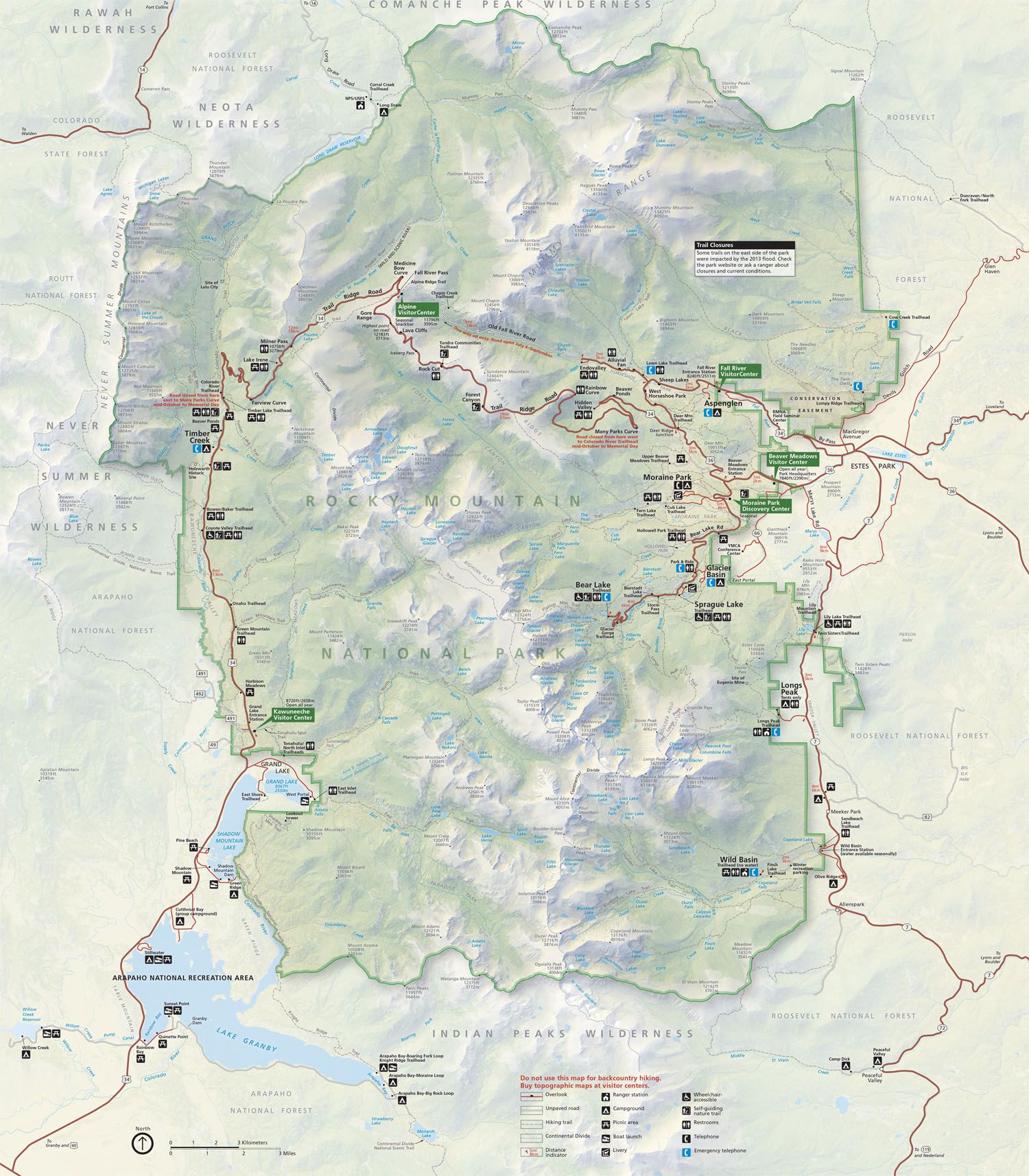
Map courtesy of the National Park Service.
How Many Days Do You Need in Rocky Mountain National Park?
Due to its large size and long list of noteworthy hikes, you need several days to explore Rocky Mountain National Park.
Ideally, plan on spending at least three days in Rocky Mountain National Park. This gives you enough time to drive Alpine Ridge Road, Old Fall River Road, and hike a few of the trails.
If you are an avid hiker, I recommend spending five or more days in Rocky Mountain National Park. This gives you enough time to acclimate to the higher elevation (very important if you live at a low elevation) before tackling some of the higher, tougher hikes (such as Mount Ida, Hallett Peak, or Longs Peak).
We spent one wonderful week in Rocky Mountain National Park in July. One week was perfect for us. This gave us enough time to hike at least one trail every day, with contingency time for bad weather. But even with a week here, there are still a lot of hikes left on our to-do list.
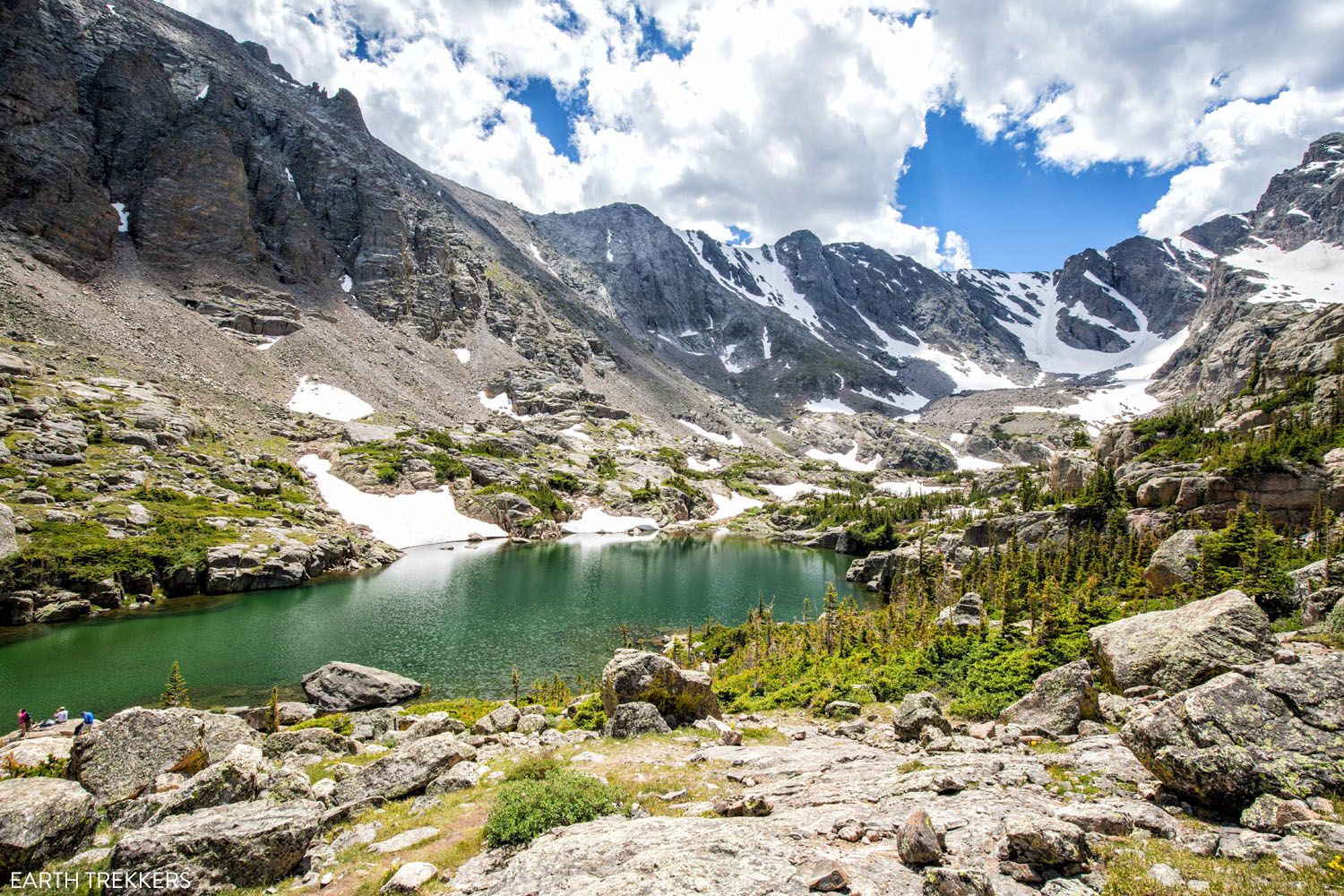
Lake of Glass, seen on the hike to Sky Pond
Important Things to Know
Timed Entry System
To visit Rocky Mountain National Park from May 23 to October 19, 2025, you will need to reserve a permit in advance.
This has been implemented to limit crowds at the busiest sections of the park during the peak visitation season (the summer months). If you do not have a reservation, you will not be allowed to enter the park. Reservations are made online on the recreation.gov website. Each daily reservation costs $2 per vehicle, which is in addition to the $25 daily entrance fee or $35 weekly fee per vehicle. Learn more on the official National Park Service website. Or visit recreation.gov to make your reservation.
There are two ticket types:
Timed Entry + Bear Lake Road: This permit gives you access to everything in Rocky Mountain National Park. It includes Bear Lake Road and the hikes that start here (Bear Lake, Emerald and Dream Lakes, Alberta Falls, Sky Pond, Hallett Peak, and Sprague Lake). The permit is in effect from 5 am to 6 pm.
Timed Entry (Doesn’t include access to Bear Lake Road): This permit gives you access to everything in Rocky Mountain National Park except for Bear Lake Road. You can drive Trail Ridge Road, visit the Alpine Visitor Center, hike to Longs Peak and to Chasm Lake, and hike Gem Lake. The permit is in effect from 9 am to 2 pm.
Elevation of Rocky Mountain National Park
This is one of the highest national parks in the USA. The elevation of the lowest sections of the park range from 5,600 to 9,500 feet. If you are coming from sea level, you will feel the effects of the altitude as soon as you do anything strenuous. At this elevation, it’s not enough to cause altitude sickness, but you will tire and get out of breath easily.
Many hikes top out over 9,000 feet, with some reaching up to 13,000 and 14,000 feet. If you are coming from a lower elevation and plan to hike to these taller peaks, you will need to spend a few days in the park, acclimating to the higher elevation, before you tackle these hikes.
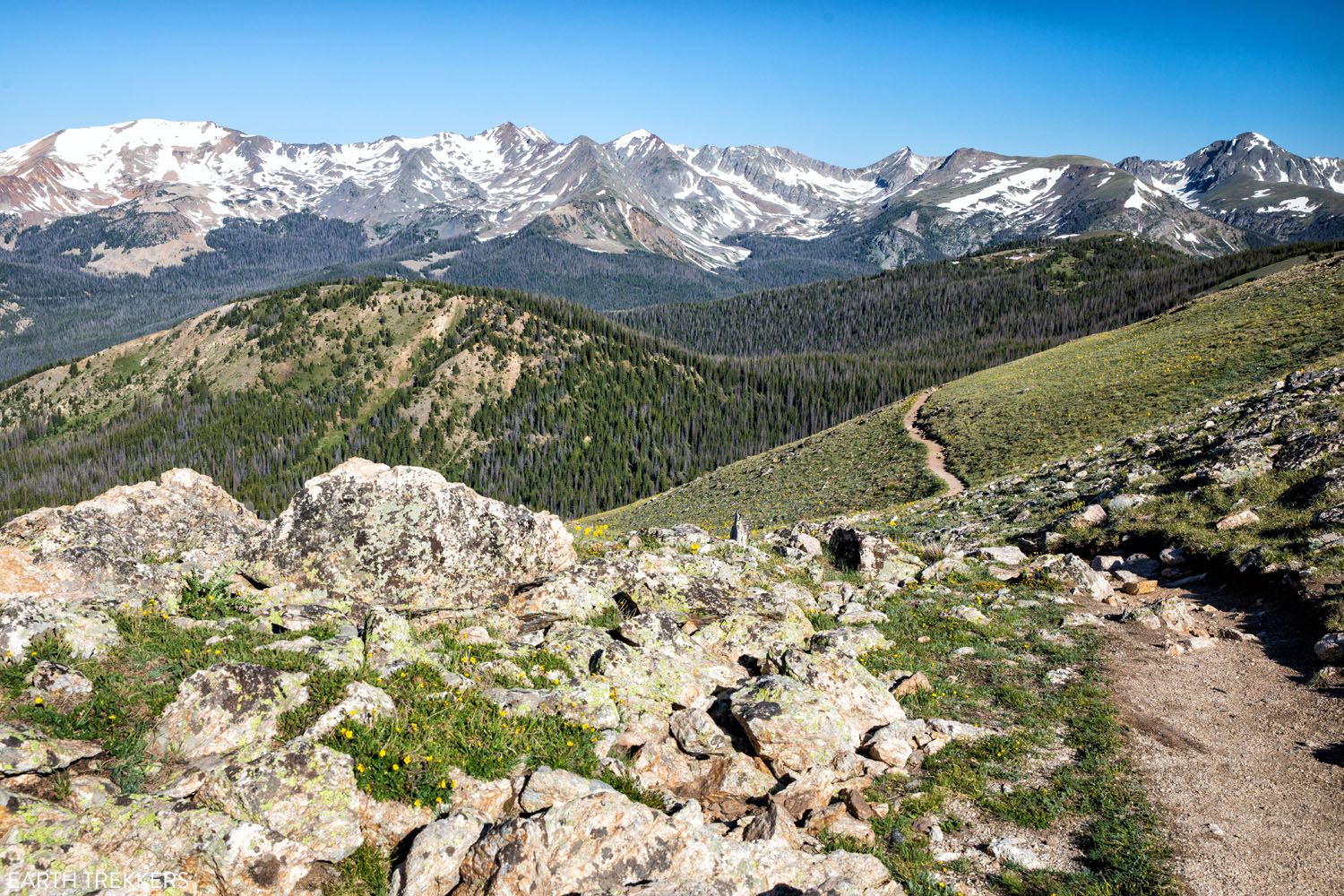
The Continental Divide Trail to Mount Ida. Most of this hike is over 11,000 feet, in the alpine tundra, so it’s best to save this hike for when you are acclimated to the altitude.
Afternoon Thunderstorms
During the summer months, afternoon thunderstorms are very common. Clouds start moving in around noon with the storms occurring almost like clockwork between 1 and 3 pm. By 4 to 5 pm, the skies begin to clear.
Thunderstorms don’t happen every single day, but it is something that you need to plan for. If you plan to go hiking during July and August, you will have to assume that there will be a 2 pm thunderstorm.
To stay safe, start your hike early in the day so that you are finished, or at least below the tree line, by 1 pm. The longer and harder the hike, the earlier you will have to start. For Longs Peak, that means starting by 3 or 4 am.
In this Rocky Mountain National Park itinerary, many of days end by the early afternoon, because of these storms. If the skies stay clear, you can stay in the park and do more exploring. But more often than not, in the summer, afternoon storms will occur.
Parking at the Trailheads
Parking at the most popular trailheads fill up extremely early in the day.
Glacier Gorge parking lot and Longs Peak trailhead parking lot fill before sunrise. The parking lot at the end of Bear Lake Road is large but from here, you have access to numerous popular trails in RMNP, so it also fills fast. Get here by 7:30 am if you want a spot.
During the busy summer months, a free shuttle service is provided by the national park service. These shuttle buses connect Moraine Park and Bear Lake, with numerous stops in between. Learn more on the National Park Service website.
Snow on the Trails
Snow can linger on the trails as late as July, especially for the trails at higher elevations. I recommend wearing waterproof hiking shoes or boots (not running or walking shoes) so that you have good traction. Hiking poles can help you keep your balance in the snow. If you plan to visit RMNP early in the summer, there is a good chance that you will encounter snow on some trails.
Also, it can snow every month of the year in Rocky Mountain National Park. In July, we hiked through a snowstorm on the way back from Sky Pond.
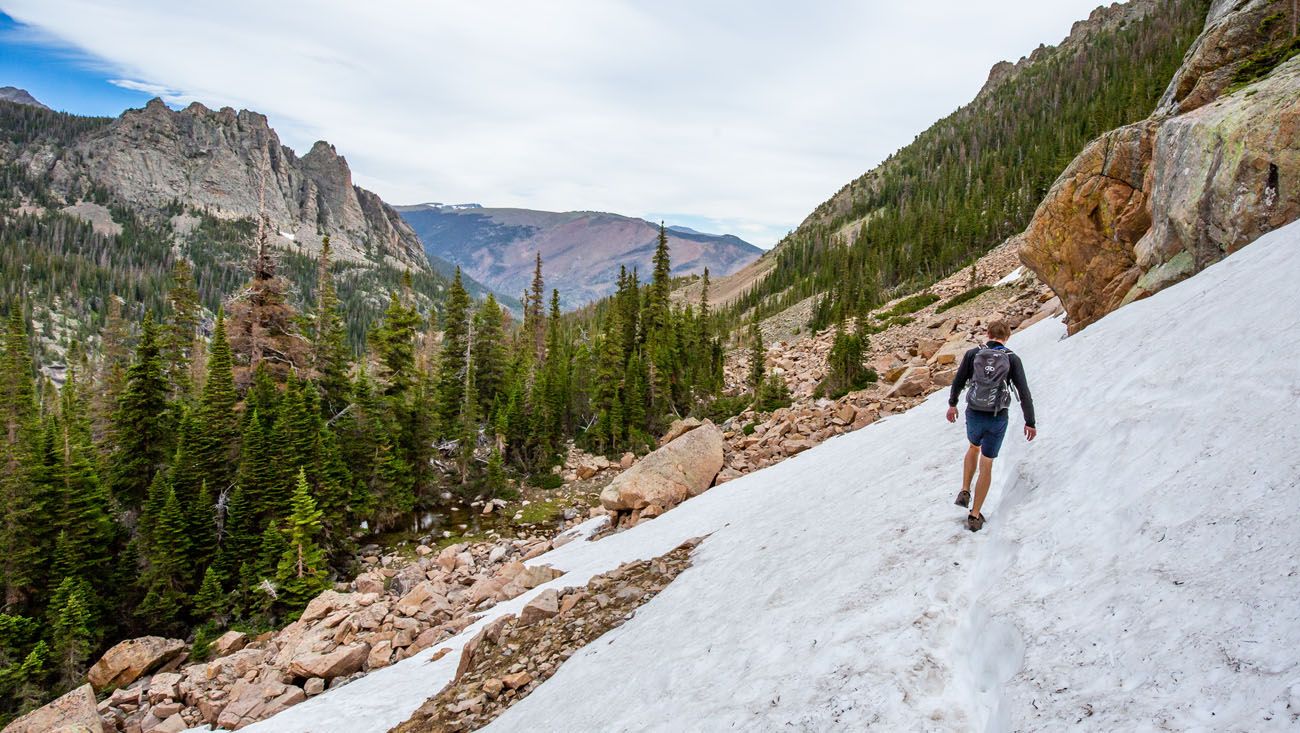
Snow on the trail in July (hiking to Fern and Odessa Lakes from Bear Lake).
Rocky Mountain National Park Itinerary
One Day in Rocky Mountain National Park
If you only have one day in Rocky Mountain National Park, it will be a busy day. Keep your fingers crossed for clear afternoon skies.
With one day, I recommend going on a hike, starting at Bear Lake, and driving Trail Ridge Road (it’s awesome!). You will need a Bear Lake Road Corridor + Full Park Access Timed Entry Ticket (Park Access +) for this day.
Morning: Hike from Bear Lake Trailhead
Park at Bear Lake Trailhead. If you are coming from Estes Park, this drive takes 30 minutes. I recommend getting here early (ideally by 7:30 am) to make sure you get a parking space and to give yourself plenty of time today.
There are a lot of hikes that start at the Bear Lake Trailhead. I recommend the shorter, easier hikes if you are not acclimated to the altitude, aren’t a big fan of hiking, and/or have more than one day in Rocky Mountain National Park.
Bear Lake: 0.6 miles, easy, 30 minutes. This is a must-do in Rocky Mountain National Park. Only 0.6 miles round trip, this flat, easy trail circles around Bear Lake.
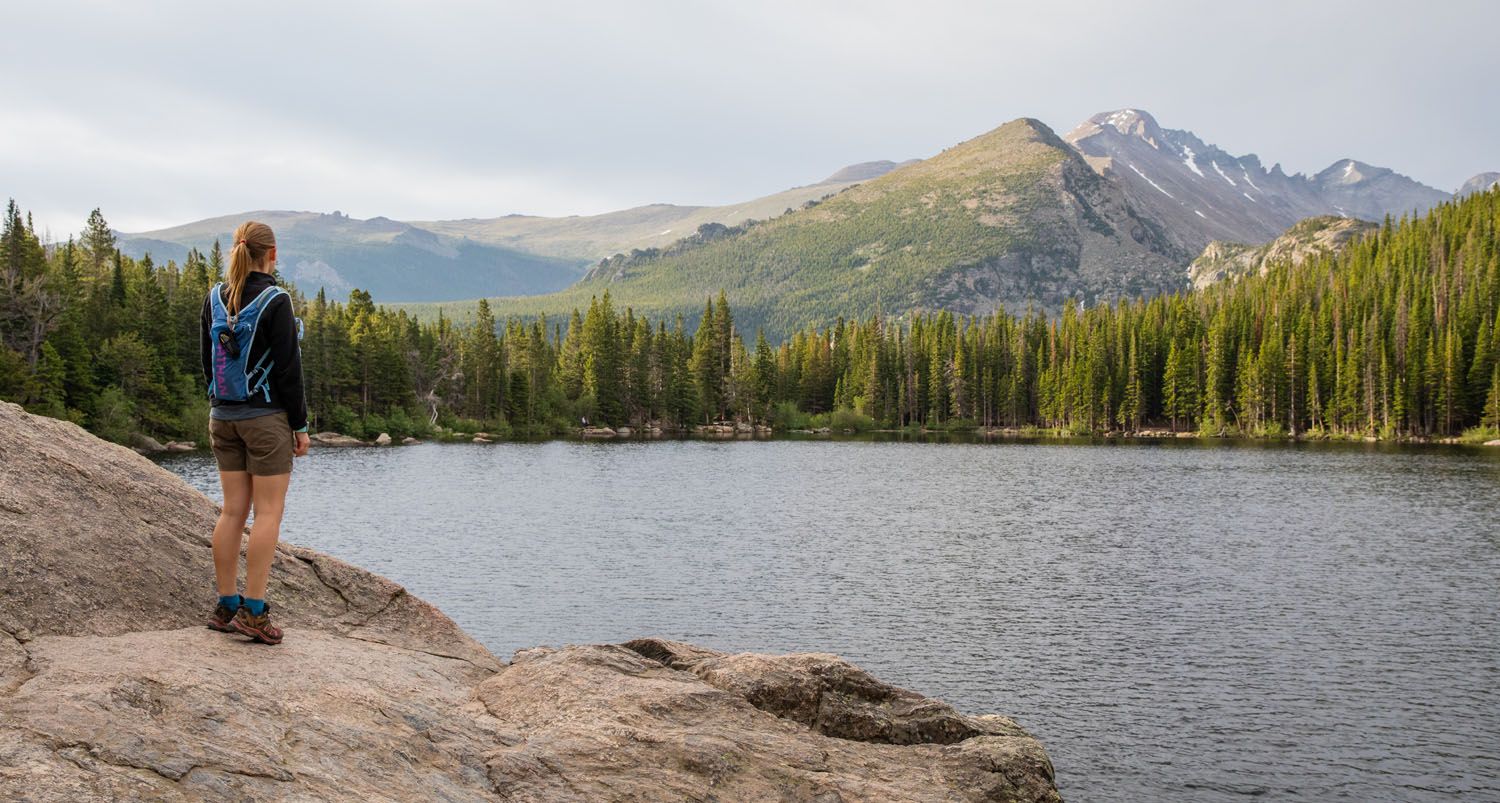
Bear Lake with Longs Peak and the Keyboard of the Winds in the background.
Alberta Falls: 2 miles, easy, 1 to 1.5 hours. Hike to one of the most popular waterfalls in RMNP. Note: It’s a slightly shorter hike (1.7 miles) if you park at the Glacier Gorge Trailhead. If you plan to hike Sky Pond, Mills Lake, or Black Lake later in this itinerary, you will pass Alberta Falls, so there is no need to hike to it today.
Nymph, Dream & Emerald Lakes: 3.6 miles, easy to moderate, 2 to 3 hours. This is the hike that I recommend for today. This family friendly hike is a great intro to hiking in Rocky Mountain National Park. With its short distance and manageable elevation gain, it is a great first hike in the park, as you acclimate to the higher elevation. Learn more in our Dream & Emerald Lake Hiking Guide.
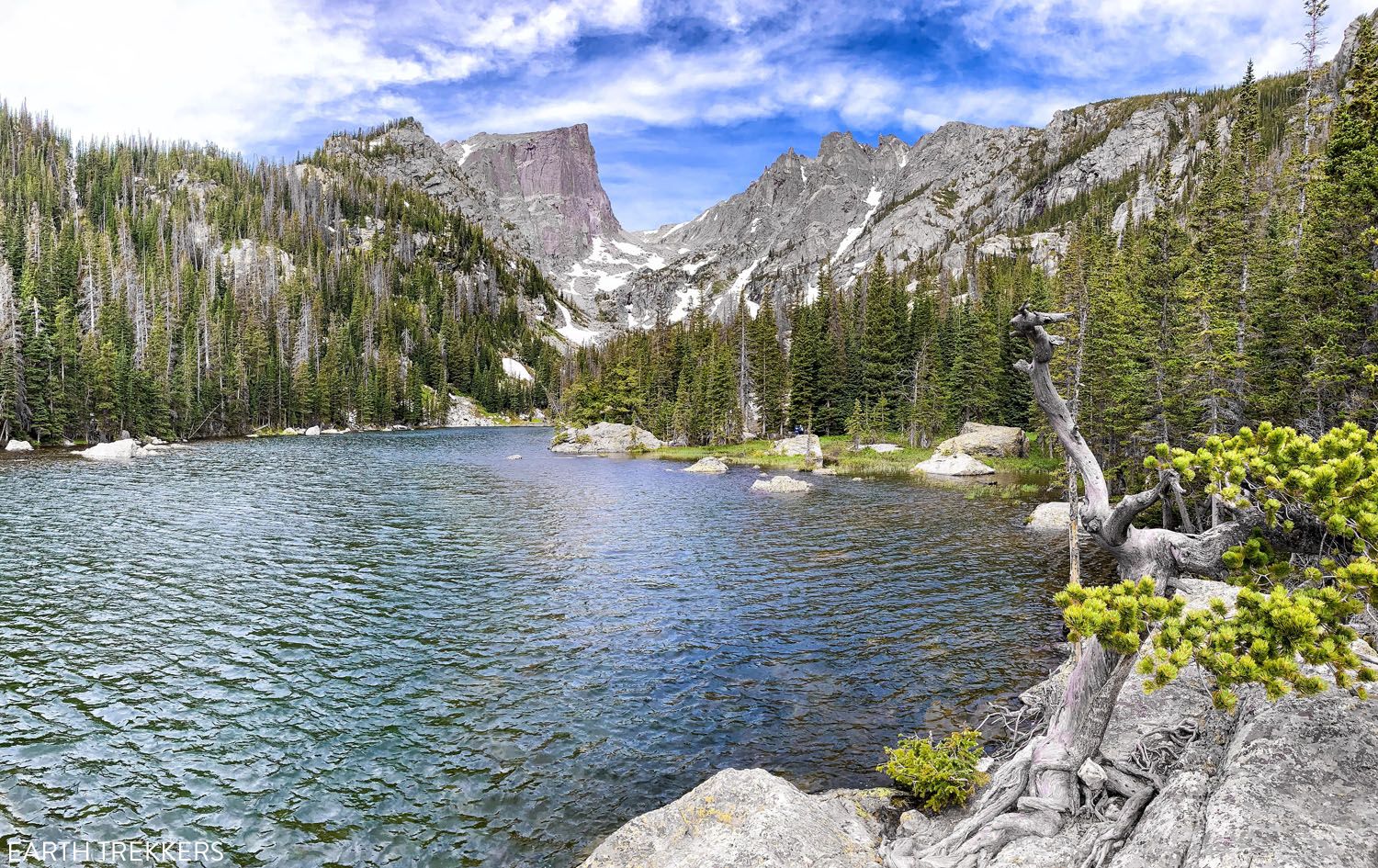
Dream Lake | Rocky Mountain National Park Itinerary
Nymph, Dream, Emerald & Bear Lakes: 4.2 miles, easy to moderate, 3 hours. Combine two of the above hikes into one great experience.
Nymph, Dream, Emerald, Haiyaha and Bear Lake: 6.2 miles, moderate, 4 to 5 hours. See five lakes in one hike. This hike adds on Lake Haiyaha, another very pretty alpine lake. Few people hike out this far so this is a great place to leave the crowds behind.
Odessa and Fern Lakes, Mills and Black Lake, Sky Pond, and Hallett Peak can all be hiked from this trailhead. However, I only recommend doing this if you are acclimated to the altitude, since these are strenuous hikes with big ascents.
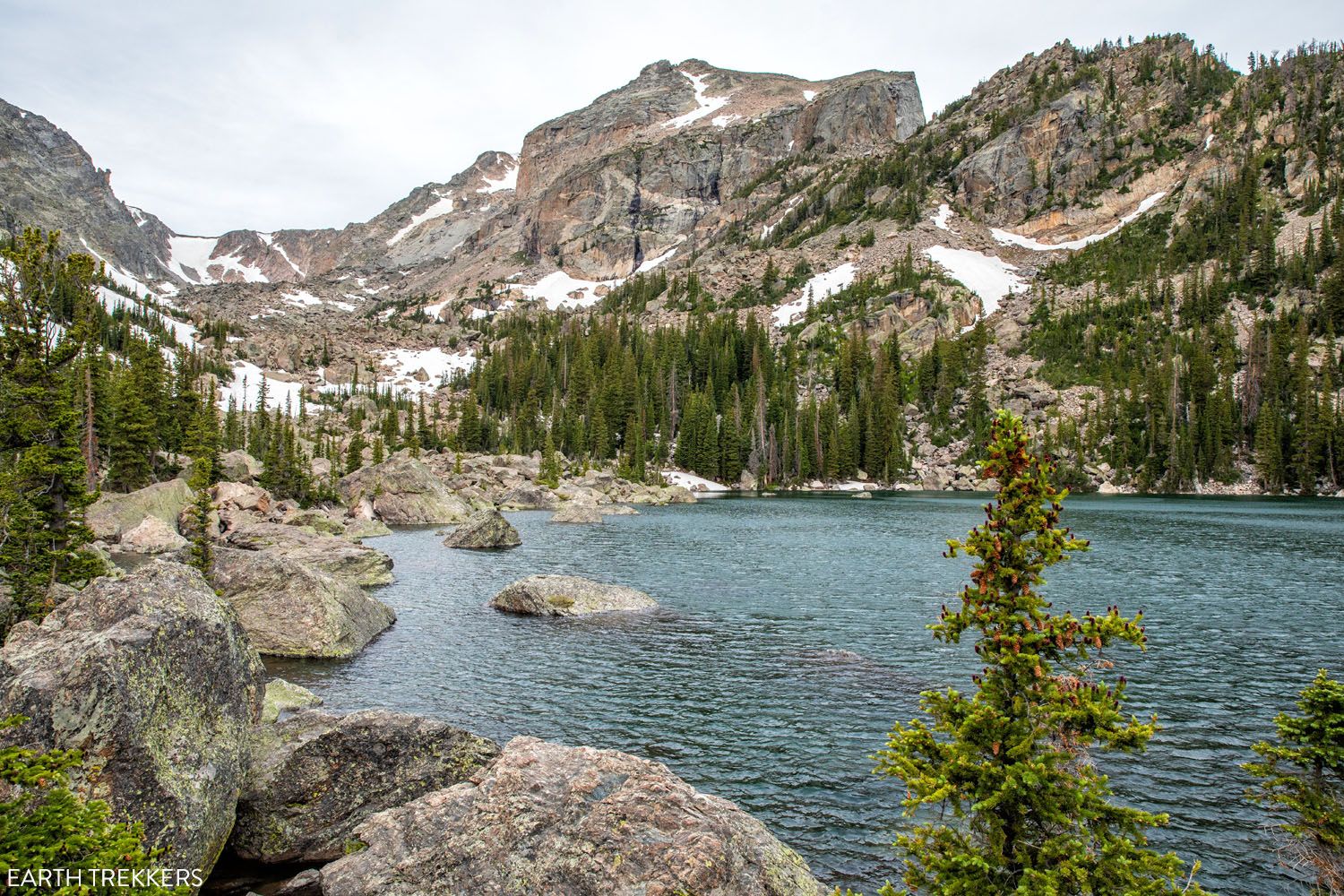
Lake Haiyaha
15 Epic Hikes in Rocky Mountain National Park
Best hikes in Rocky Mountain National Park, with stats and photos, so you know what exactly to expect.Afternoon: Trail Ridge Road
Once you are finished hiking, hop back into your car. It’s time for an amazing scenic drive in RMNP. From Bear Lake Road, turn left onto Highway 36 and continue on Trail Ridge Road.
Trail Ridge Road is 48 miles long, connecting Estes Park to Grand Lake. Eleven miles of this road is in the alpine tundra, which is over 11,000 feet. Alpine Ridge Road reaches its highest point at 12,183 feet. This is the highest continuous paved road in the United States.
This is a gorgeous drive. Along the way, there is a good chance that you will spot bighorn sheep and elk. The views from the overlooks are stunning. Don’t miss Forest Canyon Overlook, one of the best on the drive.
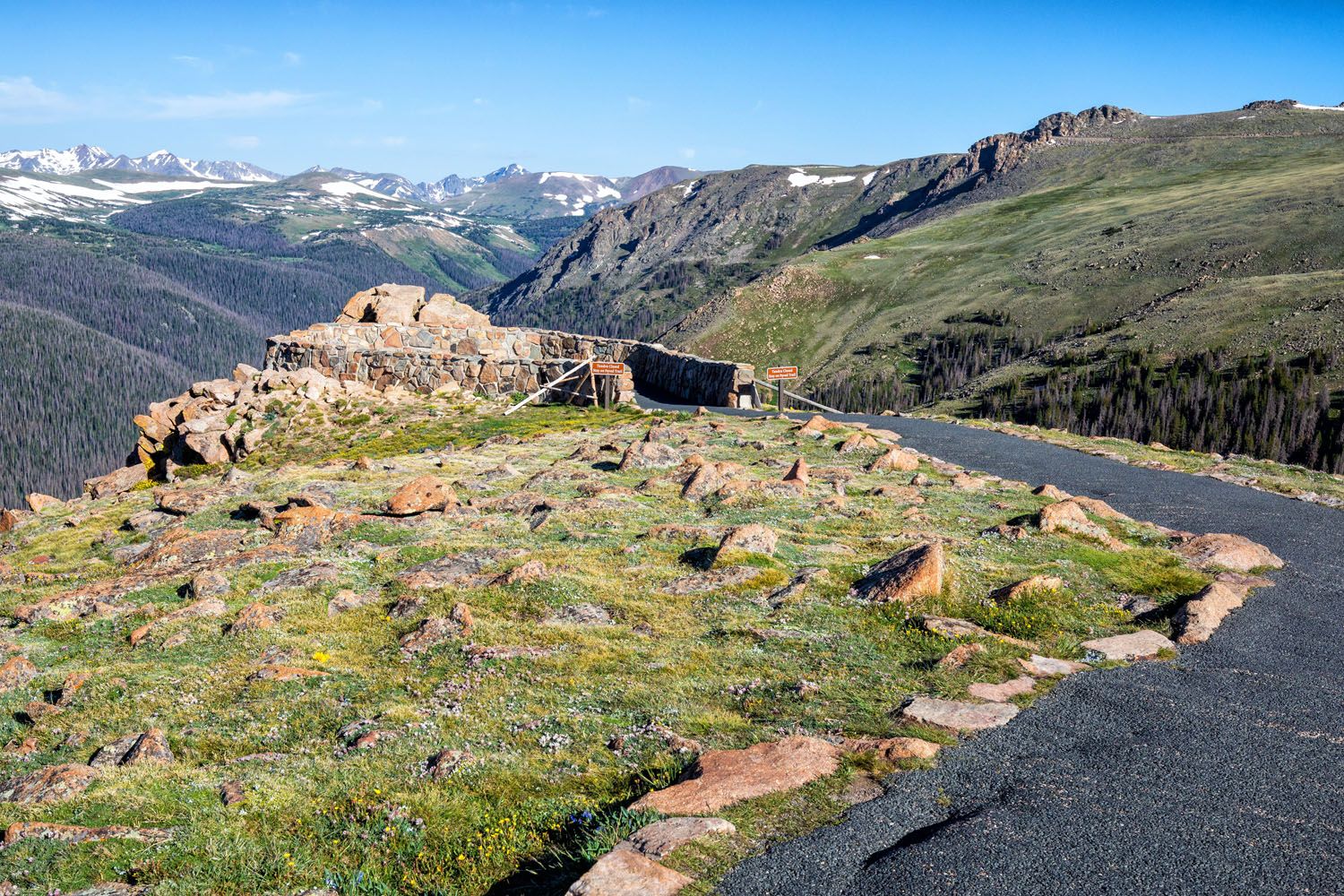
Forest Canyon Overlook
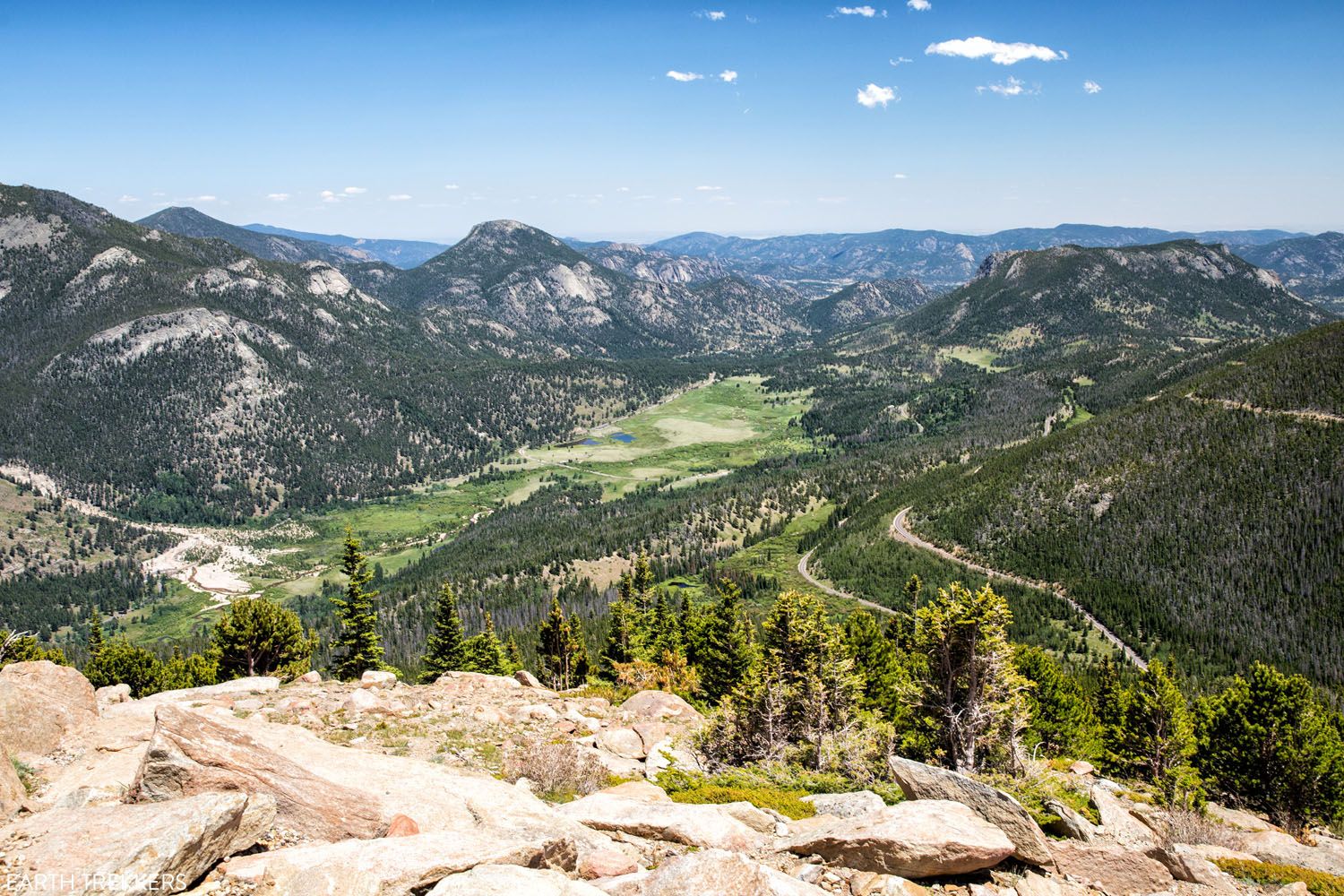
Rainbow Curve Overlook
Stop at Alpine Visitor Center, the highest visitor center in the US national parks.
From here, hike the Alpine Ridge Trail. It’s a very short hike (just over a half-mile round trip), but it will literally take your breath away. This hike starts just under 12,000 feet of elevation and it is a stair climb to the top. If you are not acclimated to the higher elevation, it is normal to get out of breath easily.
This is an essential hike in Rocky Mountain National Park. So, climb those stairs, catch your breath if you need to, and enjoy the awesome views from the top. You’ll be glad you did.
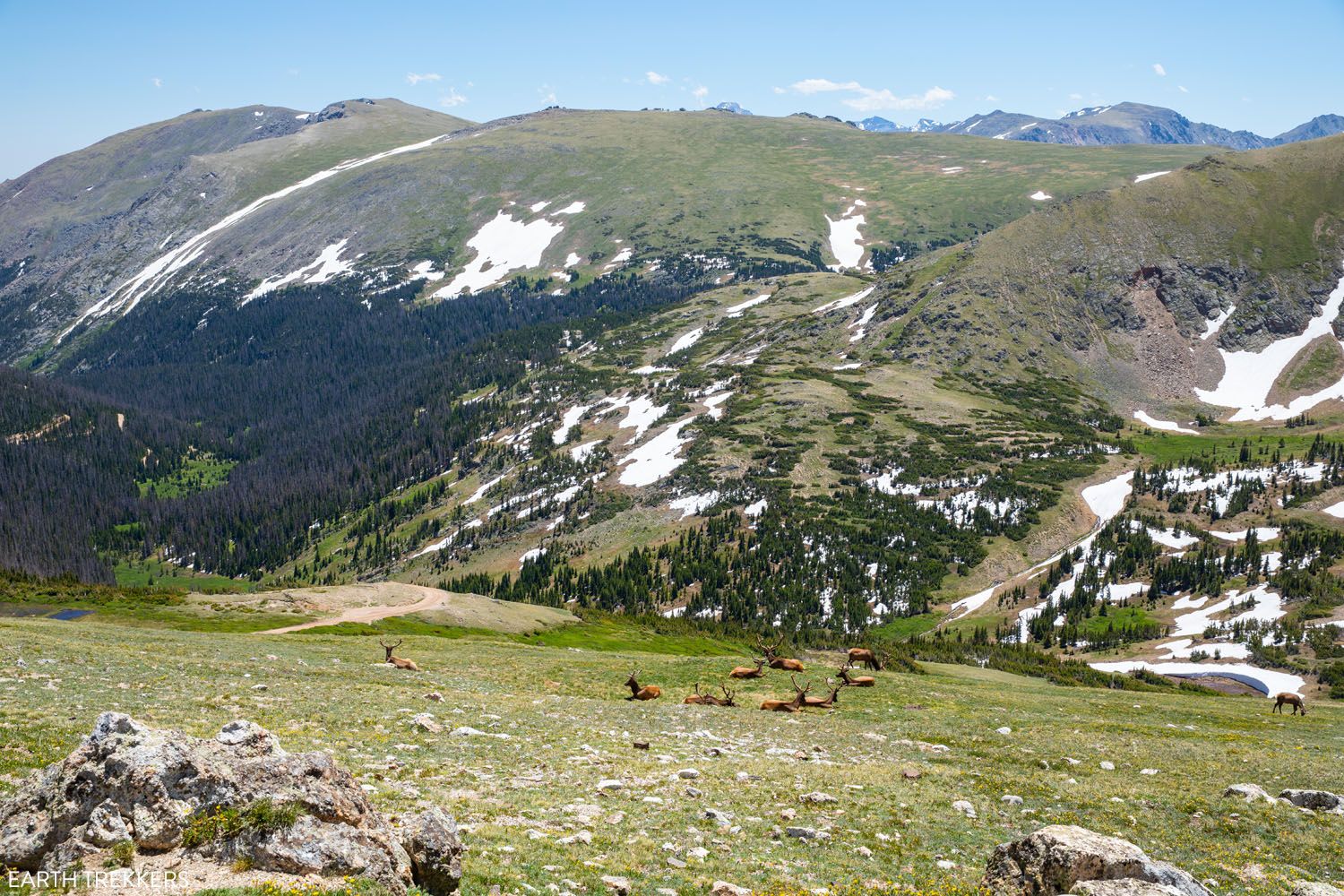
View from the Alpine Ridge Trail | Rocky Mountain National Park Itinerary
Past the Alpine Visitor Center, you can continue on Alpine Ridge Road and go all of the way to Grand Lake, if you like. For those with an interest in historical sites, make sure you visit the Holzwarth Historical Site and learn more about the life of Colorado homesteaders.
For full details on how to spend one day in Rocky Mountain National Park, read our post One Perfect Day in Rocky Mountain National Park.
Two Day Rocky Mountain National Park Itinerary
Day One
Morning: Hike Nymph, Dream, Emerald, and Bear Lakes from the Bear Lake Trailhead
Afternoon: Trail Ridge Road (if the weather is clear)
Timed Entry Ticket: Bear Lake Road Corridor + Full Park Access
Day Two
Timed Entry Ticket: Park Access (excludes Bear Lake Road Corridor) is sufficient unless you choose to hike to Fern and Odessa Lakes.
If you had afternoon thunderstorms on Day One, drive Trail Ridge Road in the morning. Visit the Alpine Visitor Center, hike Alpine Ridge Trail, and consider driving down to Grand Lake, visiting the Holzwarth Historic Site on the way. On the return drive, hike the Ute Trail to Tombstone Ridge. This easy hike offers spectacular views of Rocky Mountain National Park and it is great for all ages and ability levels. It is our favorite short hike in the park.
If the weather was clear yesterday, and you drove Trail Ridge Road, I recommend doing another hike this morning. On day two, as you are still acclimating to the altitude, I recommend one of these hikes:
Deer Mountain. 6.2 miles, moderate, 3 to 4 hours. This is a great hike for newbie hikers who want to summit a mountain in Rocky Mountain National Park. From the summit you have a great view over Moraine Park and Longs Peak.
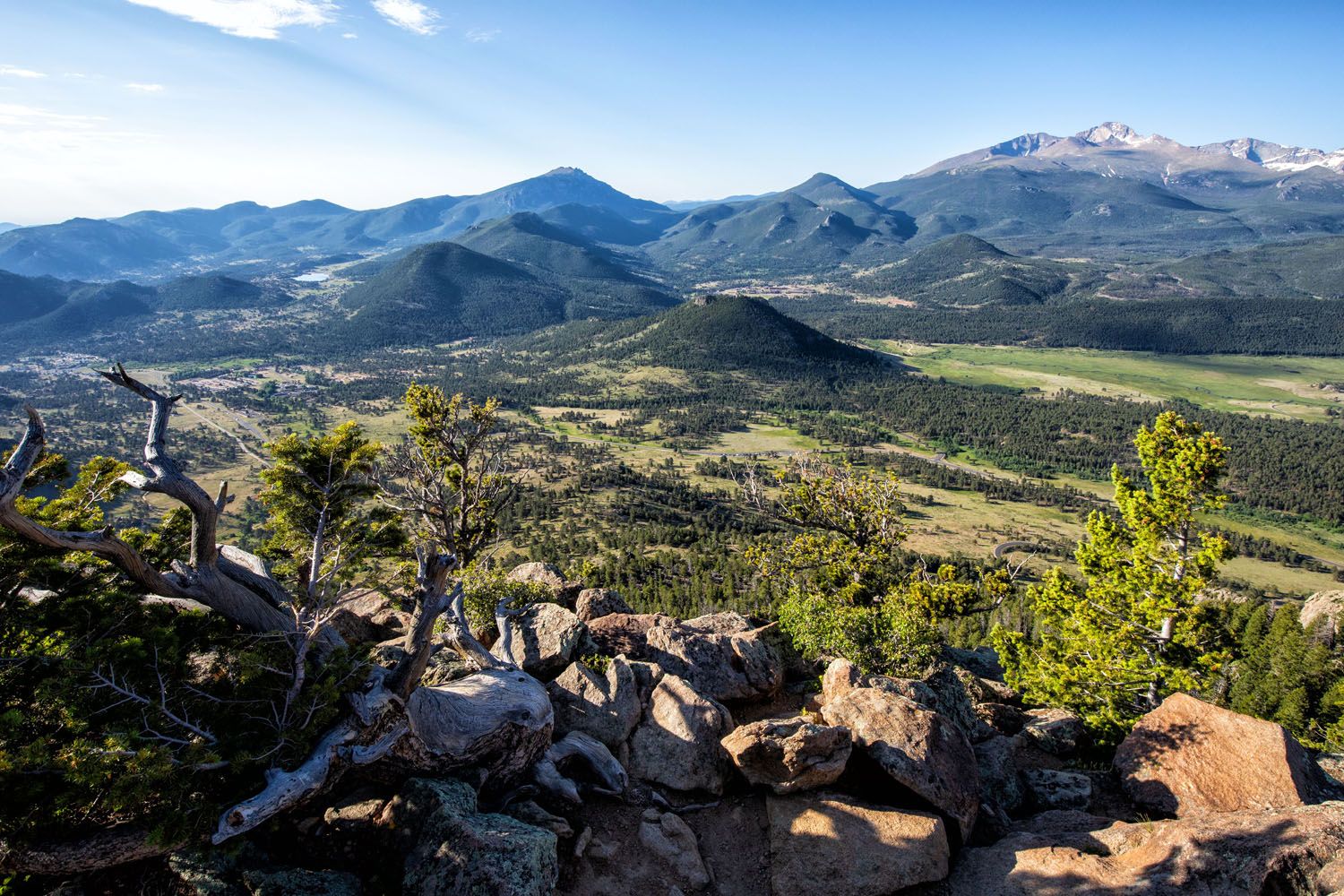
View from the summit of Deer Mountain
Gem Lake. 3.4 miles, moderate, 2 to 3 hours. This short, strenuous hike offers sweeping views over Estes Park and out to Longs Peak and it ends at a very pretty alpine lake.
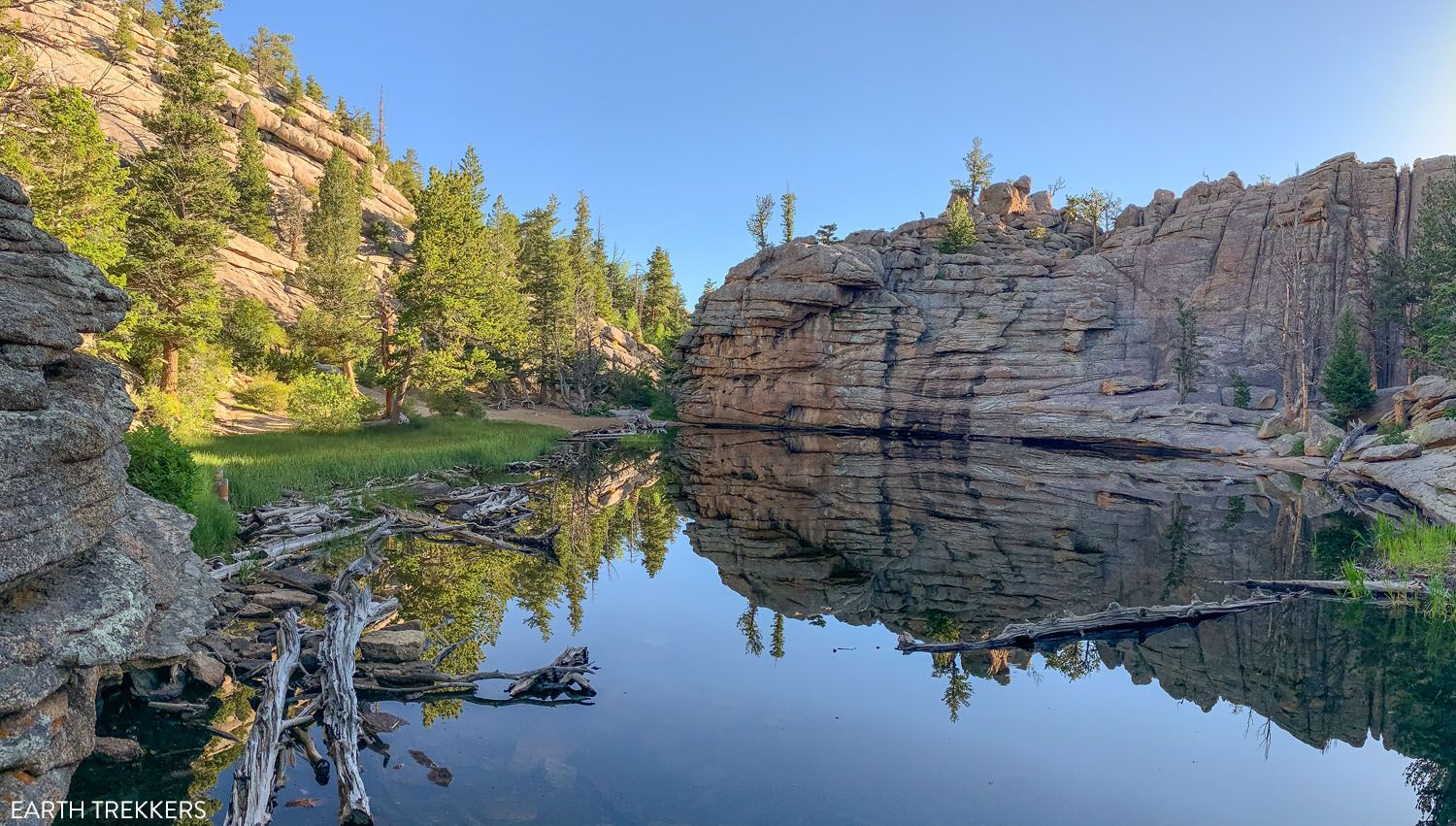
Gem Lake | Rocky Mountain National Park Itinerary
Odessa and Fern Lakes. 7.5 to 10 miles, depending on the route you choose. If you are looking for a relatively uncrowded trail with the chance to visit multiple alpine lakes, this is a nice hike to consider. You can either hike to Fern Lakes and Odessa Lake as a point-to-point hike, starting at Bear Lake and ending at Moraine Park (or vice versa). You can also hike to Fern Lake out-and-back from either Bear Lake or Moraine Park.
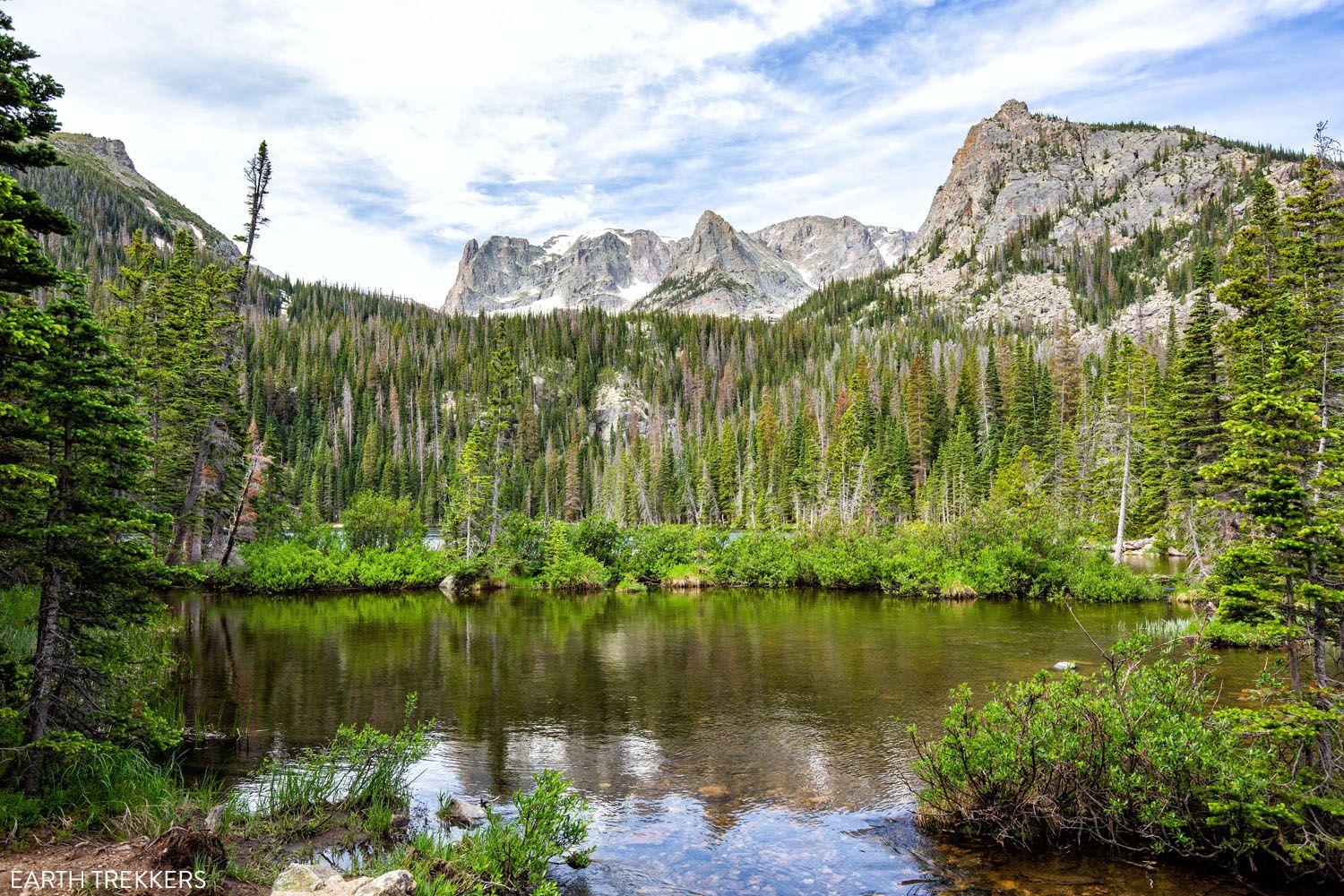
Fern Lake
Spend the afternoon and evening exploring Estes Park.
Three Day Rocky Mountain National Park Itinerary
Day One & Day Two
Follow the Two Day Rocky Mountain National Park itinerary.
Day Three
Most people will be acclimated by this point, which means that you can hike almost any trail in the park. However, if Longs Peak is on your list, I recommend waiting one more day if you come from sea level. Also, if Longs Peak is on your list, watch the weather report for your visit. I recommend hiking Longs Peak on the day with the clearest weather. Ideally, you want a day with crystal clear skies and no chance of rain.
If you are an avid hiker, you are probably ready to hike some of the longer, tougher, more thrilling hikes in the park. Here are several to choose from.
Timed Entry Ticket: You will need a Bear Lake Road Corridor + Full Park Access permit (Park Access +) if you plan to hike Sky Pond, Hallett Peak, or Mills and Black Lake. You will need a Park Access (Excludes Bear Lake Road Corridor) permit if you plan to hike Chasm Lake or Mount Ida.
Sky Pond. 9.5 miles, strenuous, 4 to 6 hours. This is our favorite hike in RMNP. This hike has a little bit of everything…waterfalls, alpine lakes, high mountain views, and fun river and stream crossings. But the real reason for doing this is for the incredible view of Sky Pond, one of the most spectacular alpine lakes in the USA.
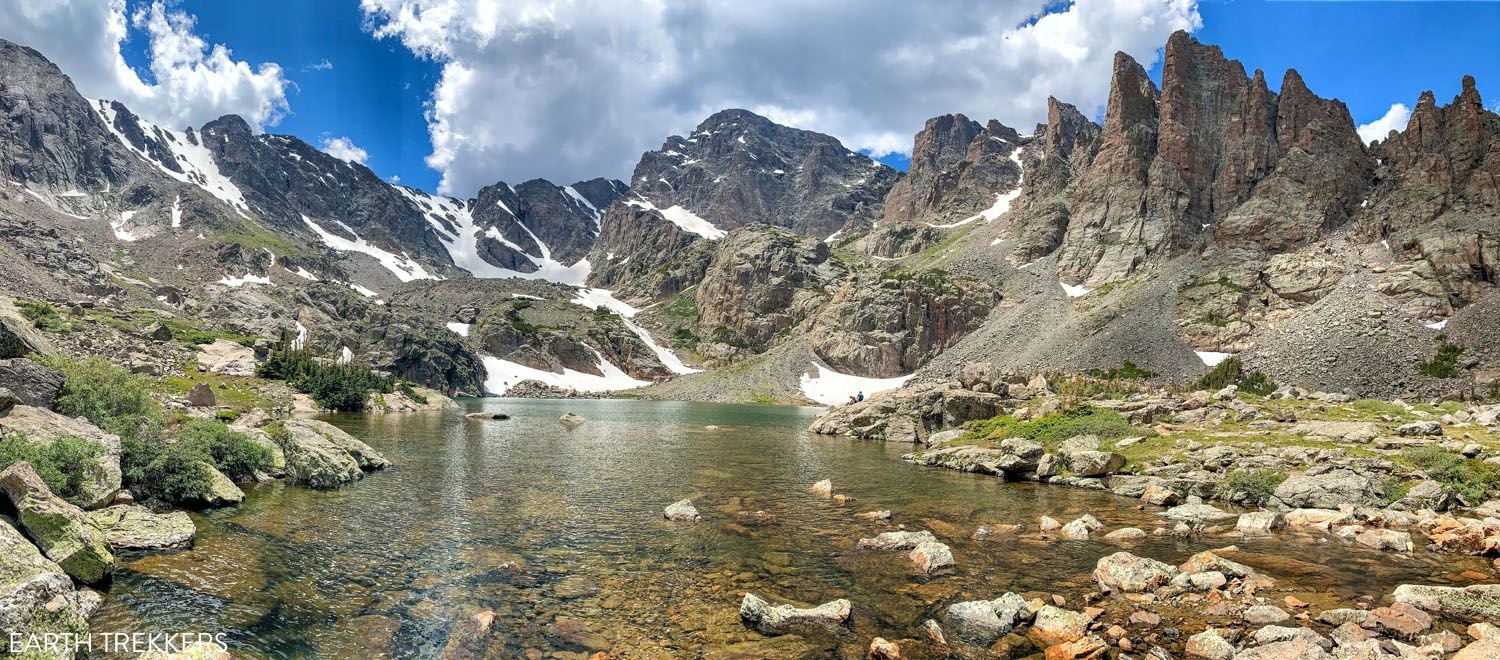
Sky Pond
Chasm Lake. 9 miles, strenuous, 4 to 6 hours. For the first part of this hike you will be sharing the trail with those on their way to Longs Peak. After the trail split, the hike gets easier and the views of Longs Peak and the alpine landscape is jaw-dropping. After one final short and strenuous climb you arrive at Chasm Lake.
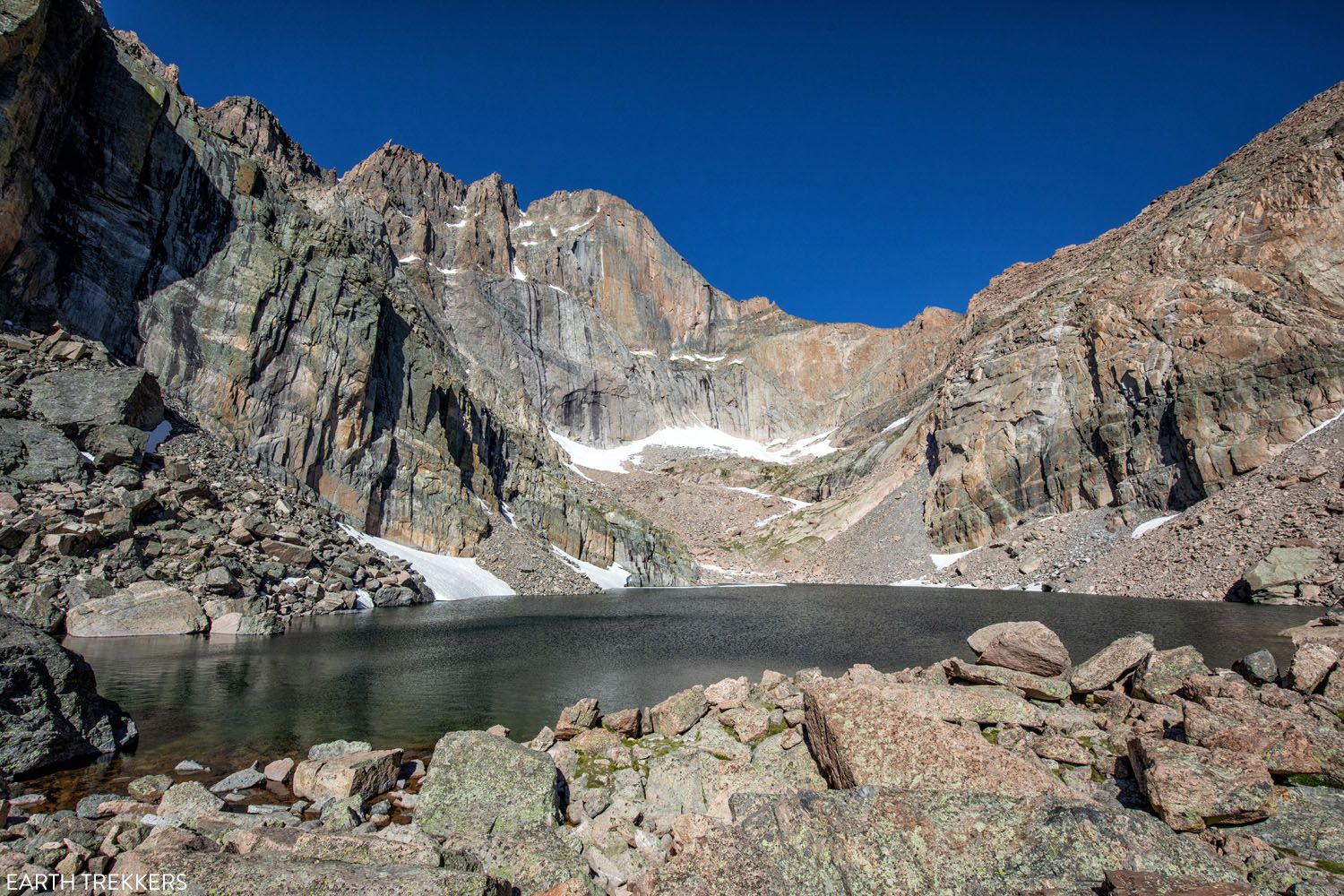
Chasm Lake | Rocky Mountain National Park Itinerary
Mount Ida. 9.8 miles, strenuous, 4.5 to 6.5 hours. This hike is much different than many other hikes in Rocky Mountain National Park. You spend very little time below the tree line, so the views are incredible for most of the hike. Plus, this is a lesser known hike, so the trail gets a lower number of hikers than other hikes on this list. This tough hike follows along the Continental Divide, starting at 10,800 feet and tops out at 12,899 feet on Mount Ida. You will really feel the effects of the altitude. And once at top…what a view.! This is another one of our favorite hikes.
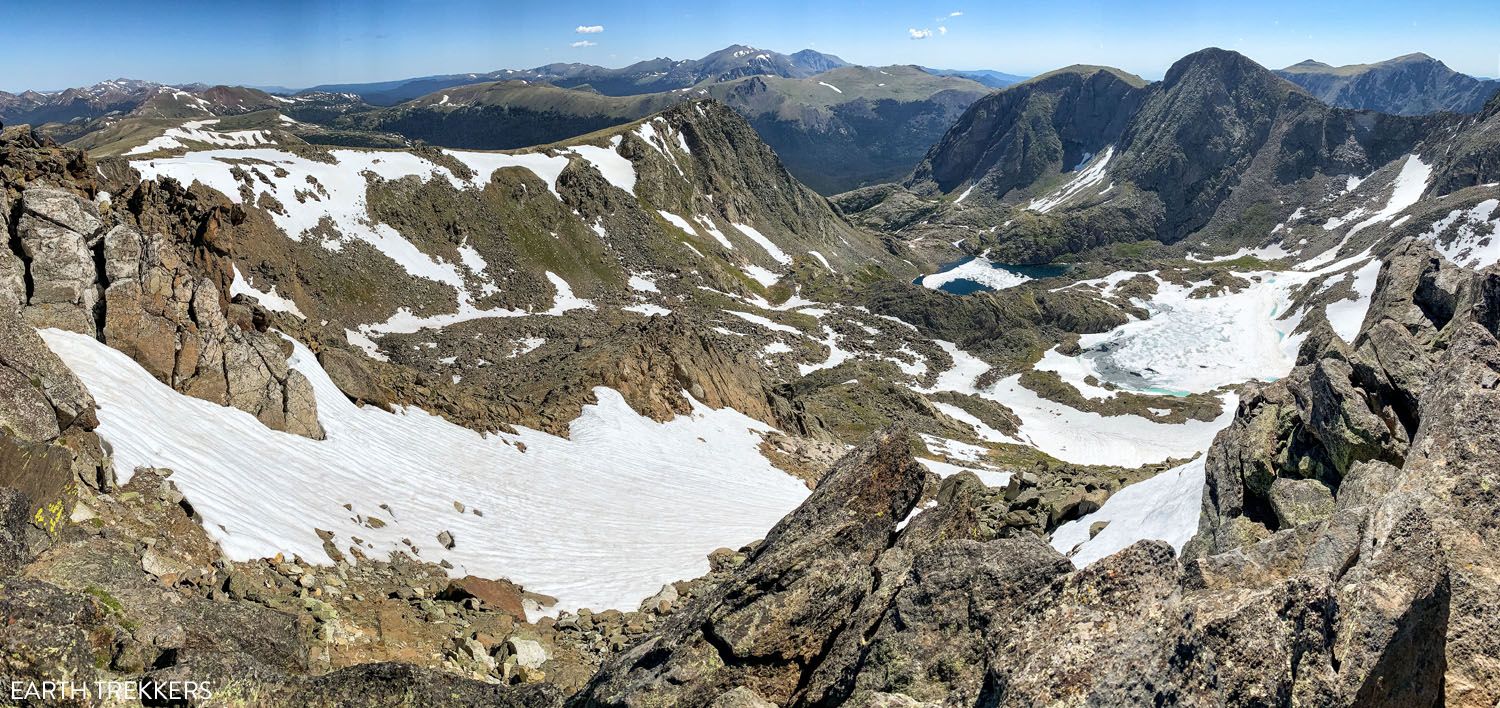
View from Mount Ida
Flattop Mountain to Hallett Peak. 10.4 miles, strenuous, 6 to 8 hours. This hike starts at Bear Lake and summits Flattop Mountain before arriving at Hallett Peak. You are now standing at 12,718 feet, with 360° views, which makes this one of the best hikes in Rocky Mountain National Park. This is a great warm-up for those who plan to hike Longs Peak.
Mills and Black Lake. 10 miles, moderate, 5 to 7 hours. Black Lake and Mills Lake are often labeled as two of the prettiest lakes in Rocky Mountain National Park. You will hike past Alberta Falls, wind around lovely Mills Lake, and end at Black Lake. Black Lake looks similar to Chasm Lake, as both of these alpine lakes are surrounded by jagged mountain peaks.
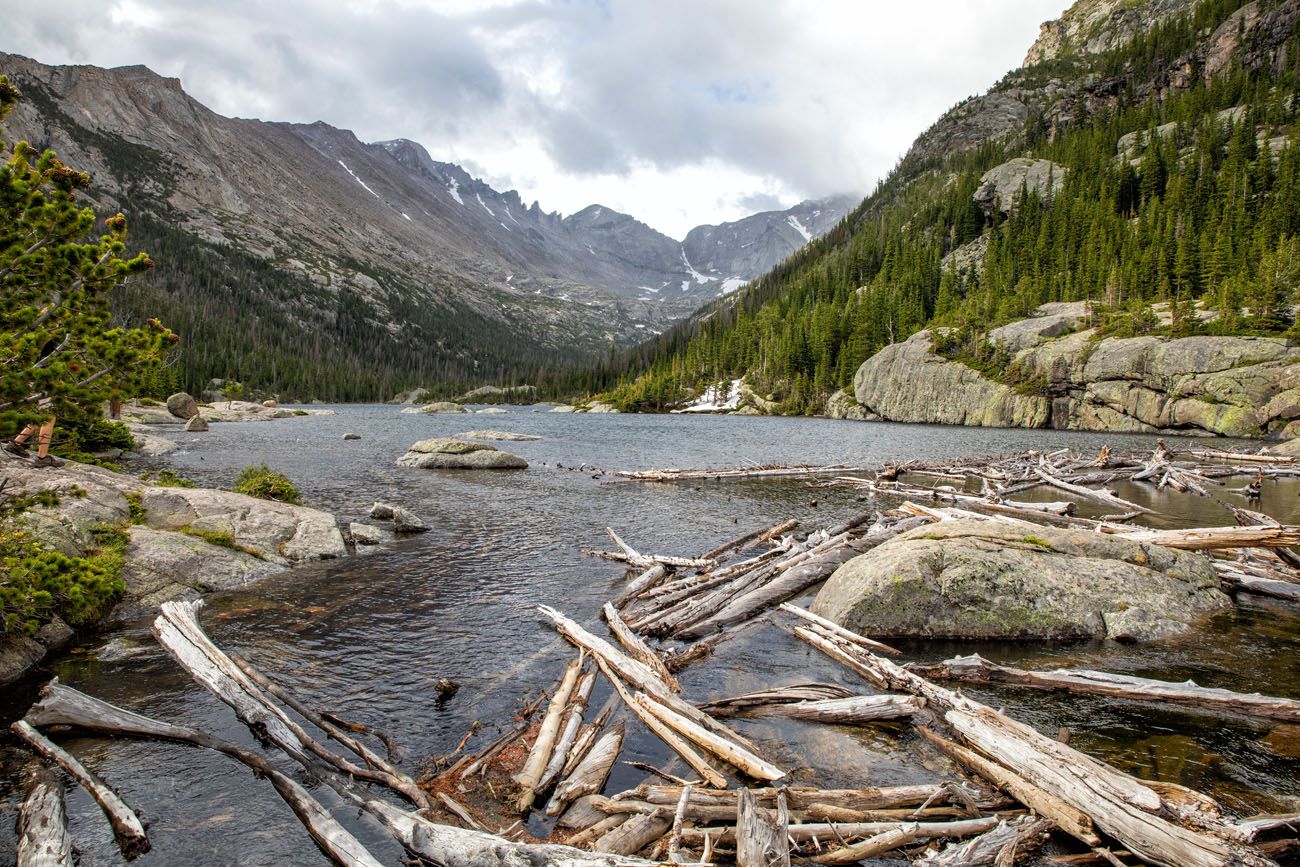
Mills Lake
Four Day Rocky Mountain National Park Itinerary
Day One, Two & Three
Follow the three day Rocky Mountain National Park itinerary.
Day Four
You have a choice today: take a break from hiking and explore Rocky Mountain National Park and Estes Park, or hike another trail.
Option #1: Old Fall River Road and Estes Park
Old Fall River Road is an 11-mile long gravel road that runs one-way from Horseshoe Park (near Estes Park) and ends at the Alpine Visitor Center.
This road opened in 1920 at it was the first road that led into Rocky Mountain National Park.
If you like scenic drives and going off-the-beaten-path, you’ll love this drive. The scenery is beautiful, as you gradually twist and turn through the mountains to get to the Alpine Visitor Center. Along the way, it’s a quick stop to see Chasm Falls.
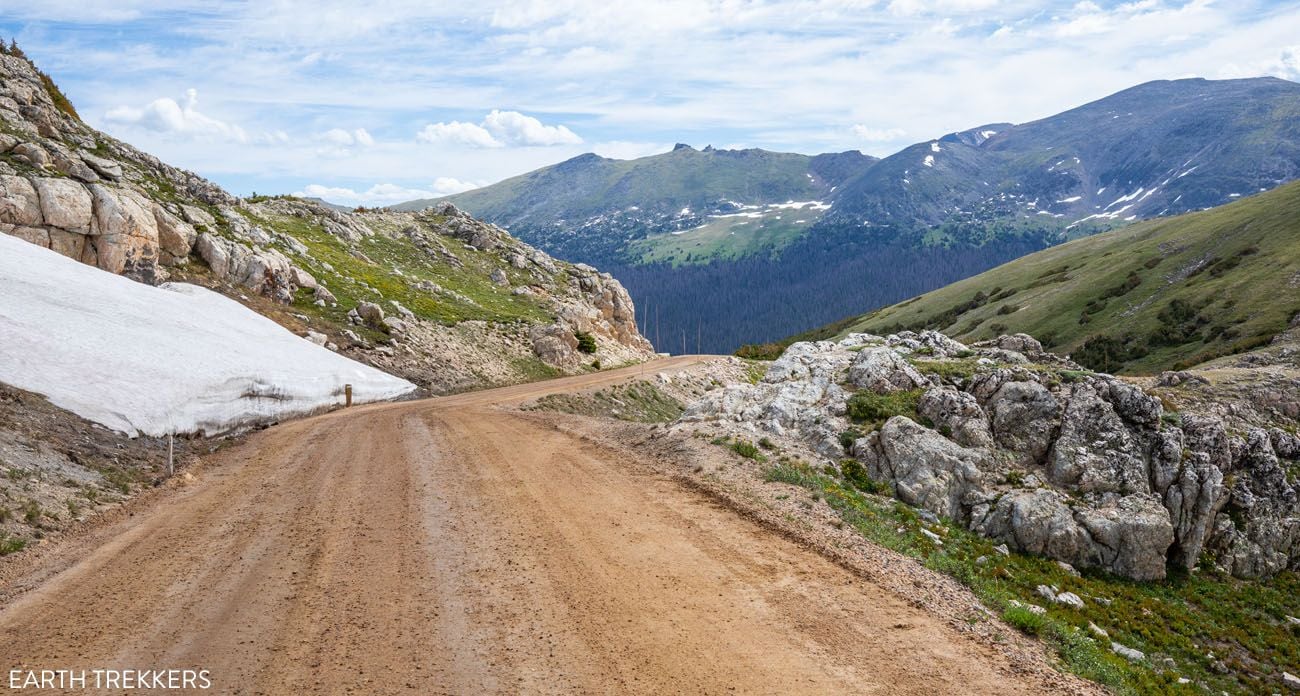
Old Fall River Road
Note: You do not need a 4×4 for this drive. The road is well-graded and suitable for standard cars. However, Old Fall River Road is only open during the summer months. Get updates on road conditions on the national park service website.
From the Alpine Visitor Center, drive Alpine Ridge Road back to Estes Park. If you did not do it yet, you have the option to hike the short but sweet Ute Trail to Tombstone Ridge. Yes, I know, I said no hiking today, but I couldn’t resist adding this one in. 😊
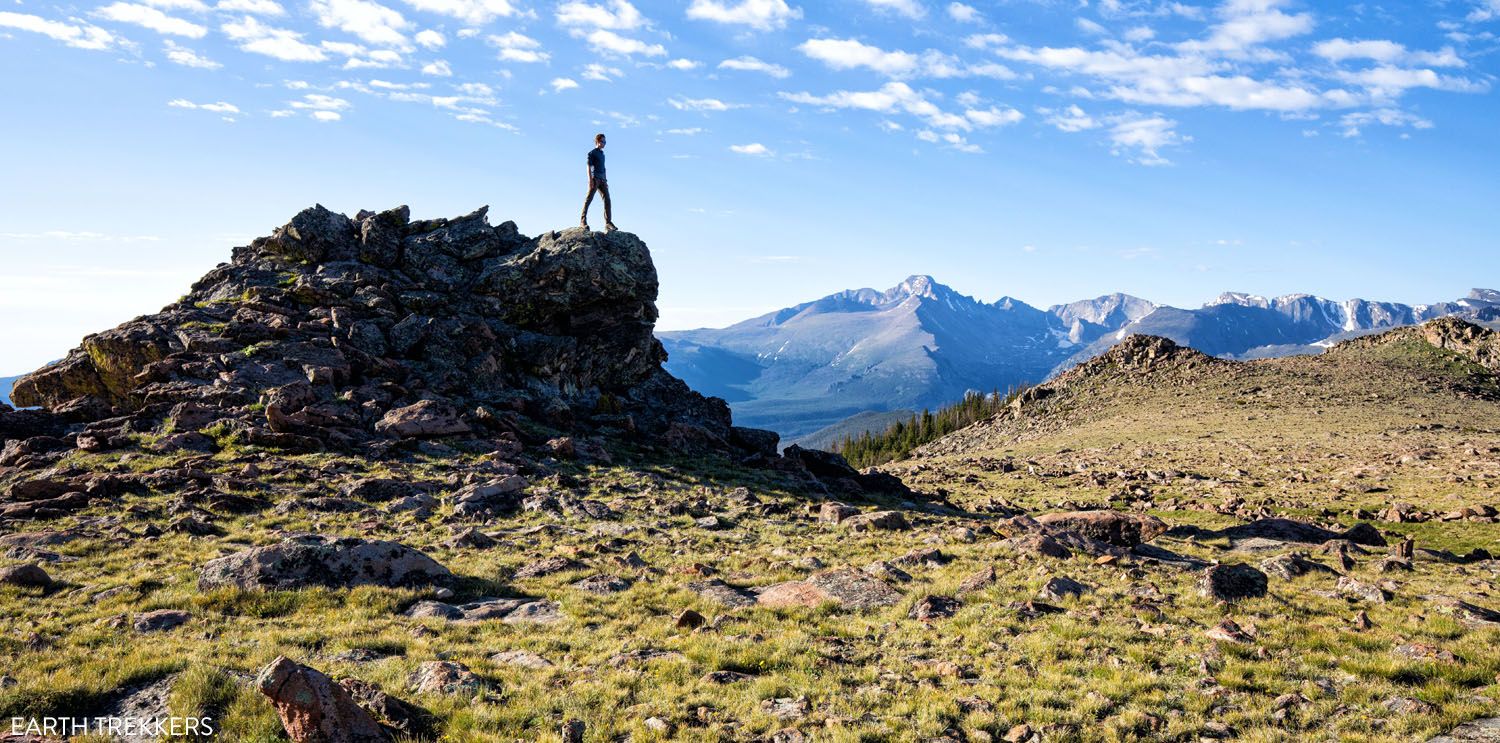
Tombstone Ridge
Spend the rest of the day in Estes Park. There are many things to do here. Take a tour of the historic Stanley Hotel, ride the Aerial Tramway to the peak of Prospect Mountain, go shopping, walk the Riverwalk, visit Lake Estes, play mini-golf, or visit a winery or brewery. For a longer list, read our post about Estes Park.
A Park Access (Excludes Bear Lake Road Corridor) timed entry ticket is sufficient for this day.
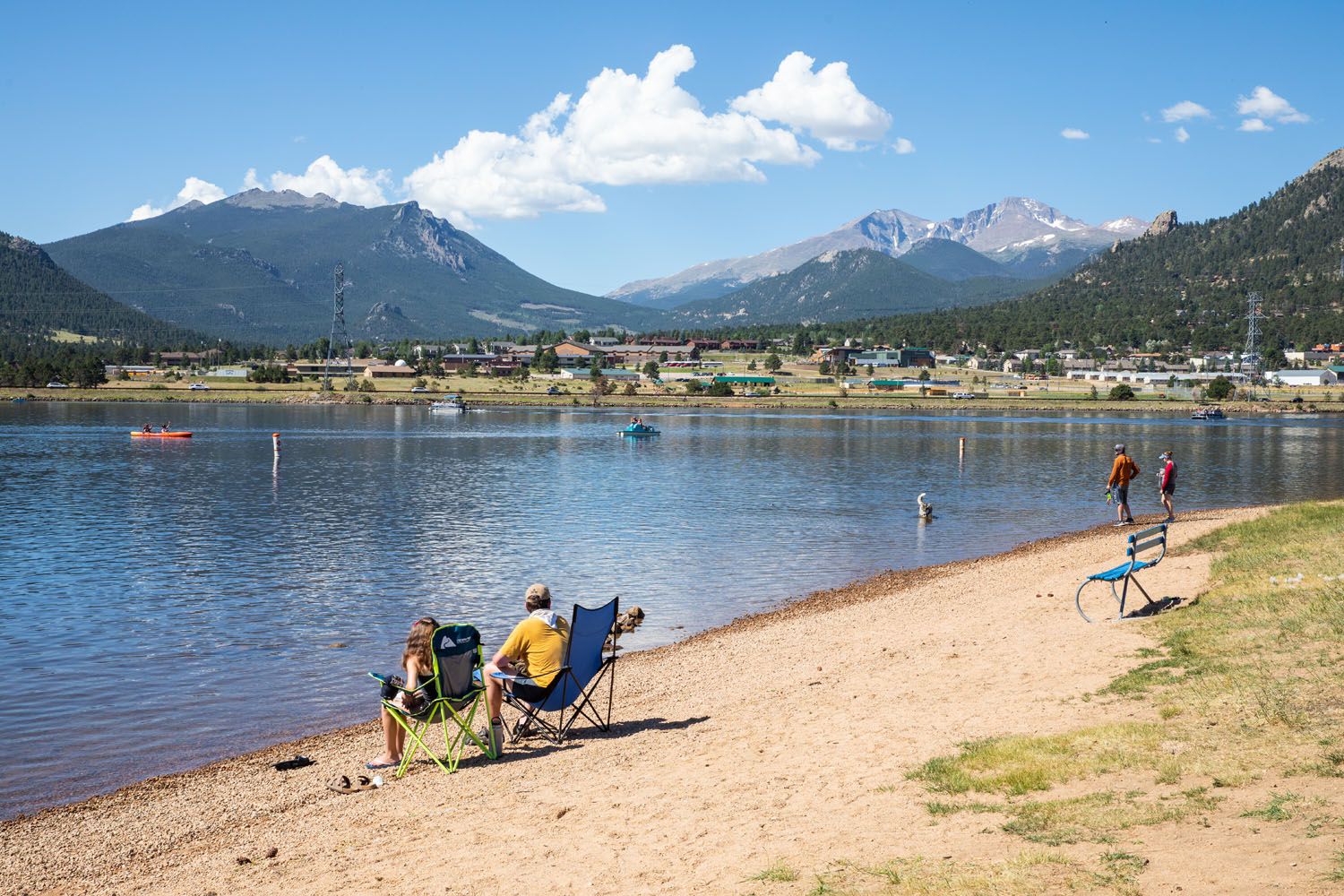
Lake Estes
Option #2: Go for a Hike
Hike one of the trails that I mentioned earlier in this itinerary, or click here to see our list of 15 great hikes to do in Rocky Mountain National Park.
If the skies are clear, the weather forecast is favorable, and Longs Peak is on your bucket list, go for it today.
Five or More Days in Rocky Mountain National Park Itinerary
If you have five or more days in Rocky Mountain National Park (lucky you!), you can spend the mornings hiking and the afternoons relaxing in Estes Park or wherever you might be staying.
We spent seven days in RMNP and every day we did at least one hike. It does get tiring, but these trails are so much fun and offer such a wide variety of views and experiences that it never gets monotonous or boring.
For five days or more, follow our four day itinerary and for each additional day that you have, add on another hike.
If you are an avid hiker, your itinerary will look something like this:
Day 1: Nymph, Dream & Emerald Lakes plus Trail Ridge Road and the Alpine Ridge Trail
Day 2: Deer Mountain in the morning, Estes Park in the afternoon/evening
Day 3: Sky Pond
Day 4: Continental Divide Trail to Mount Ida
Day 5: Longs Peak
Day 6: Rest day from hiking (Old Fall River Road and activities in Estes Park)
Day 7: Chasm Lake
If you have no desire to fill each day with a hike, your itinerary will look something like this:
Day 1: Nymph, Dream & Emerald Lakes plus Trail Ridge Road and the Alpine Ridge Trail
Day 2: Gem Lake in the morning, Estes Park in the afternoon
Day 3: Sky Pond
Day 4: Old Fall River Road and Estes Park
Day 5: Mills and Black Lakes
Day 6: More activities in Estes Park
Day 7: Deer Mountain
There are a million different ways to put together a Rocky Mountain National Park itinerary, and how you choose to do so really depends on your interests, the time of year you plan to visit the park, and the weather.
I think it’s a good idea to have a basic plan of what you want to do while at RMNP but be flexible. Watch the weather, enjoy the time you spend in the park, and you might find you want to hike more, or less, than you expected to.
Rocky Mountain National Park is a beautiful place so we hope you have a wonderful time here.
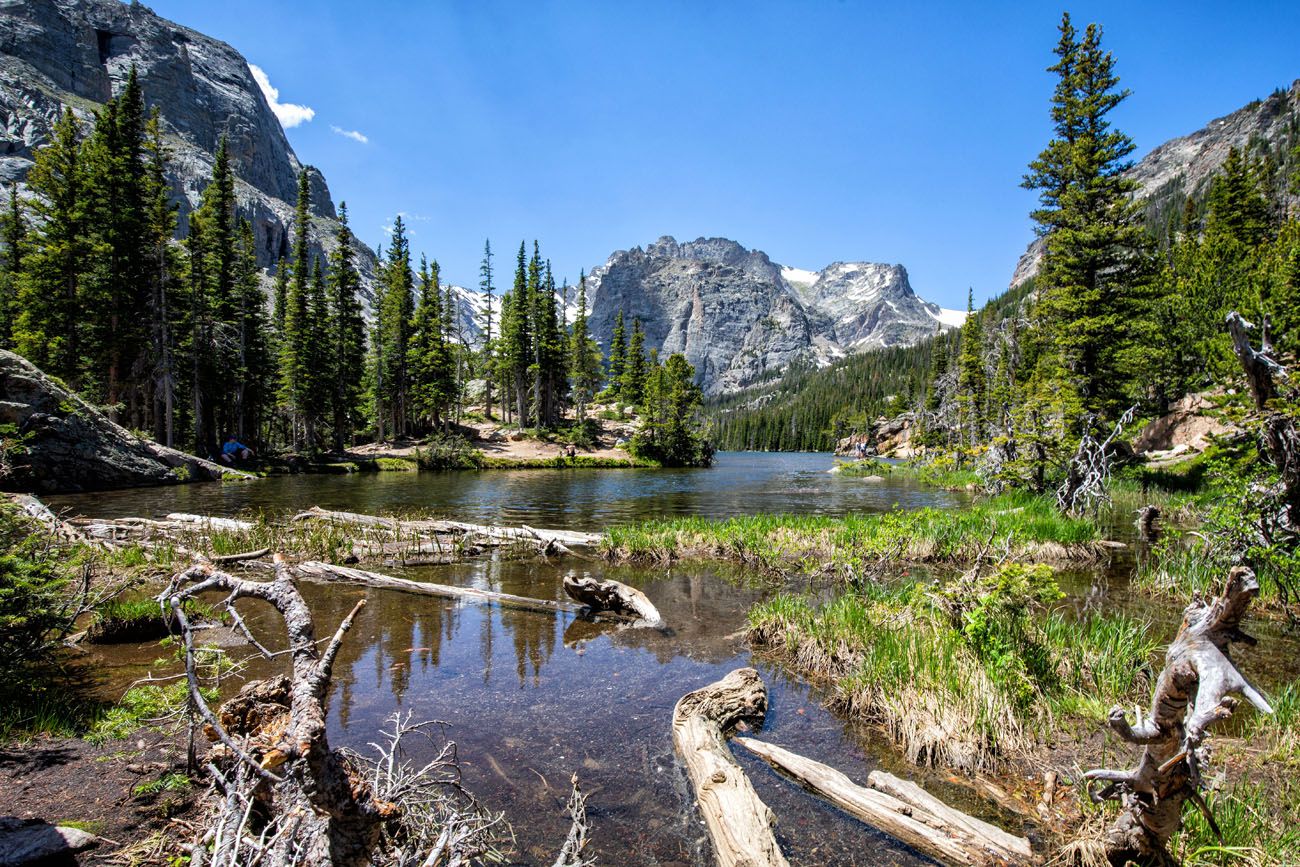
The Loch. You can hike here from Glacier Gorge or Bear Lake Trailhead. If you hike to Sky Pond, you will hike through the Loch to get there.
When to Visit Rocky Mountain National Park
The best time for this Rocky Mountain National Park itinerary is from Memorial Day through mid-October, when Trail Ridge Road is open. During this time, you will be able to drive through the park, with access to all of the hikes and overlooks.
When Trail Ridge Road closes, there will be no access to the west side of the park, if you are staying in Estes Park. That means you will not be able to visit the Alpine Visitor Center, hike the Ute Trail to Tombstone Ridge, drive Old Fall River Road, or visit some of the best overlooks in the park.
Rocky Mountain National Park is open all year. Once the snow begins to fall, you can still hike many of the trails that we list, but you will need snowshoes. During the winter months, cross-country skiing is also a popular activity. You can follow this itinerary during the winter months with some modifications. For many visitors, the winter months are their favorite time to visit RMNP. The park is quieter and with the snow, it is a winter wonderland.
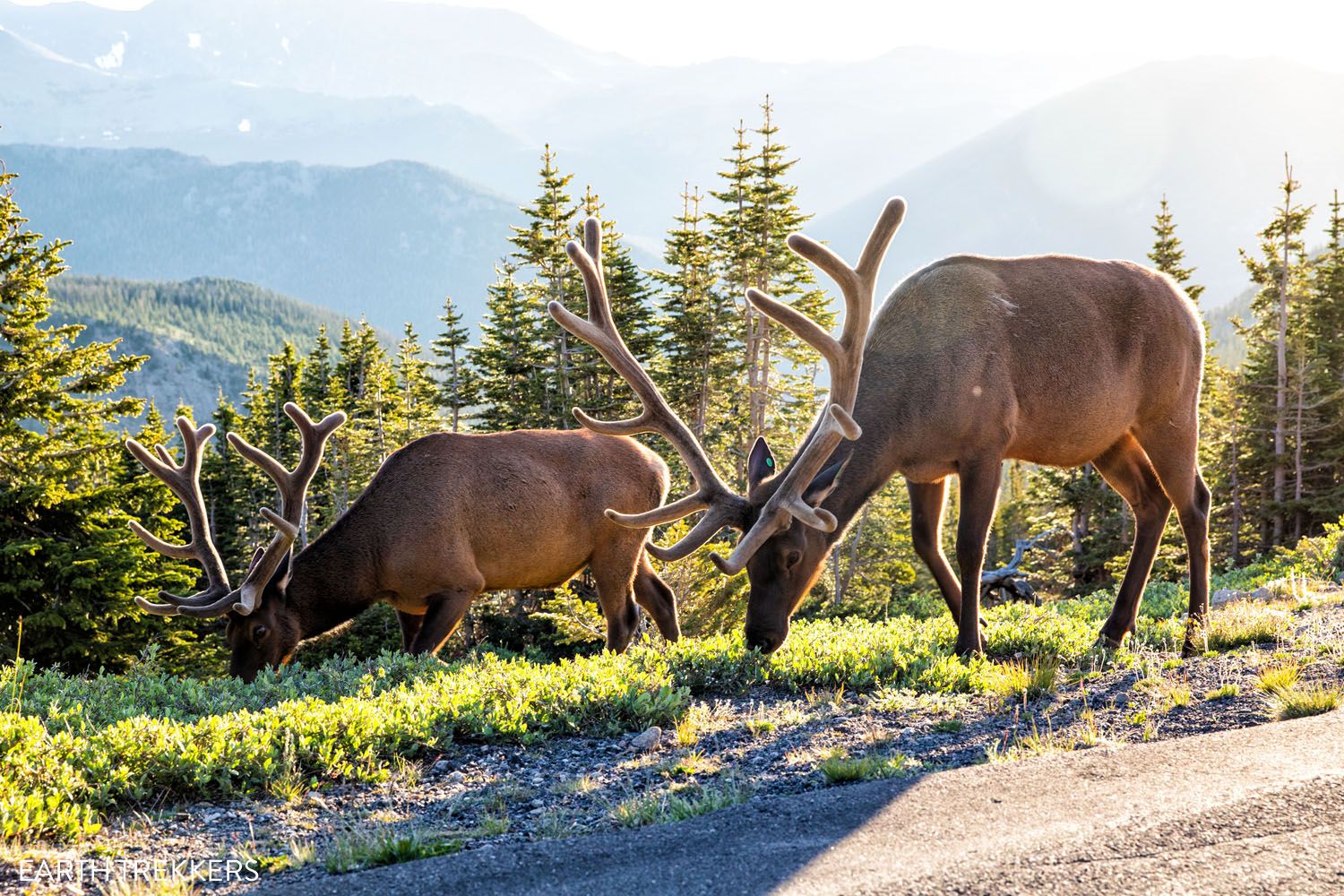
Elk on Trail Ridge Road
Where to Stay
In Rocky Mountain National Park
If you want to stay in the park, you will be limited to campgrounds. There is no lodging inside Rocky Mountain National Park. Aspenglen, Moraine Park, and Glacier Basin are the most popular campgrounds and these get reserved well in advance. Longs Peak and Timber Creek Campgrounds are easier to get reservations.
In Estes Park
With numerous hotels and restaurants, and a great location near the heart of Rocky Mountain National Park, Estes Park is a great place to stay.
The Stanley Hotel. This historic hotel is one of the top places to stay in Estes Park. This is the hotel that inspired Stephen King to write The Shining.
The Stanley Hotel offers a wide range of rooms. The rooms within the main hotel building get mixed reviews. Some visitors complain of noise and hot temperatures in the summer (there is no air conditioning). The Aspire rooms are higher-end, modernly decorated rooms but many people state that they are overpriced for what you get.
I recommend staying at The Residences. Take your pick from one, two, three, and four bedroom houses that come equipped with a full kitchen. Each residence is individually managed, so some are better than others. We stayed in a 3-bedroom house, #402, and it was perfect. Plenty of room, good WiFi, nice furnishings, and beautiful views from our balcony. I highly recommend this particular residence.
WorldMark Estes Park. This very highly rated property offers two-bedroom apartments that can accommodate up to six people. It is located just outside of Estes Park, on the south side, an excellent location for driving into the park.
The Inn on Fall River & Fall River Cabins. This property is located west of Estes Park on Fall River Road, so you will have a longer drive to get into the heart of the park. However, this property gets rave reviews. You can stay in a cozy cabin with a river view or a well-decorated suite. There is even a three-bedroom house that can accommodate up to nine people.
For more information about where to stay and where to eat, read our Guide to Estes Park.
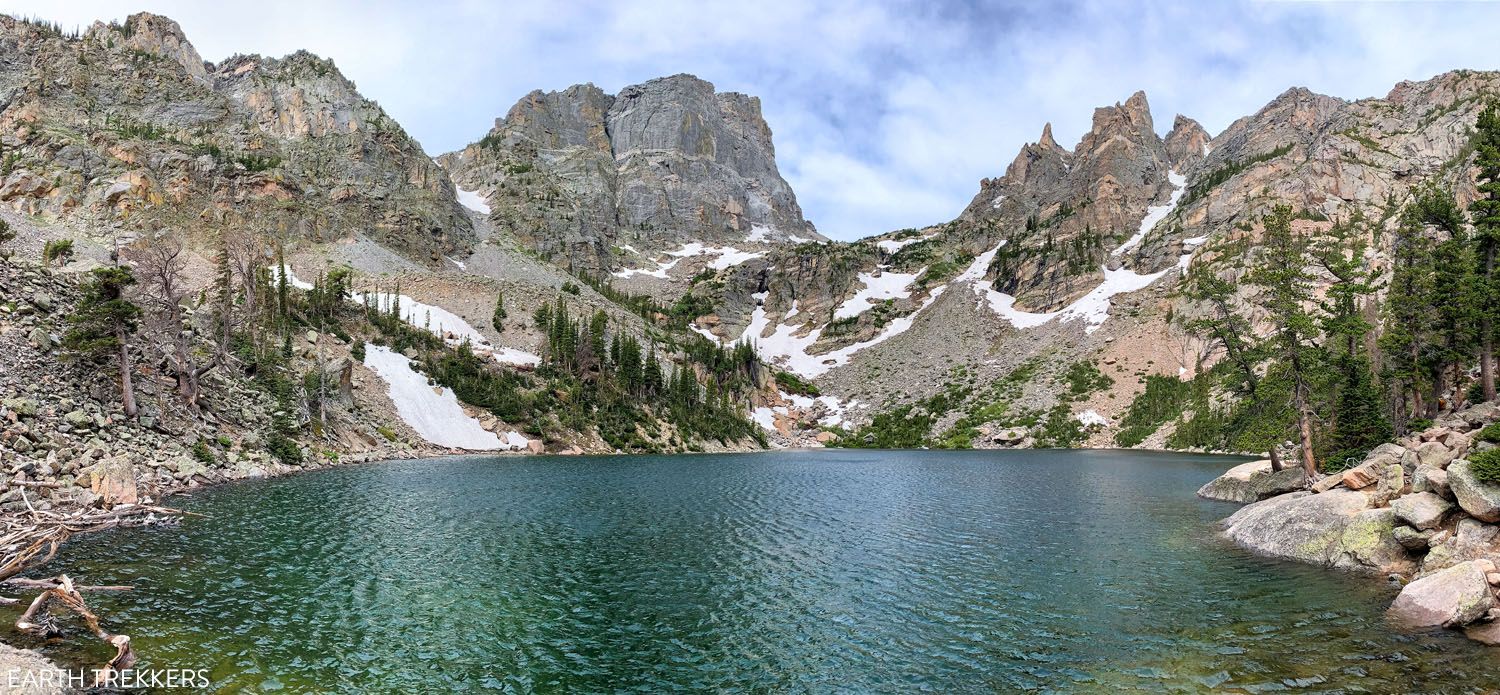
Emerald Lake | Rocky Mountain National Park Itinerary
Practical Information
Park Hours: Park entrances are open 24 hours a day, 365 days per year.
Park Fee: $25 per vehicle, valid for 1 day. $35 per vehicle, valid for one week. If you plan to visit multiple national parks, consider purchasing the America the Beautiful Pass ($80 and valid for all of the national parks for one year).
Timed Entry Permit: If you have plans to visit the park in the summer months, don’t forget to reserve your permit in advance. Learn more here.
Get updates on trail closures and park conditions on the National Park Service website.
Frequently Asked Questions
When is the best time to visit Rocky Mountain National Park?
If you plan to do a lot of hiking and drive Trail Ridge Road, plan on visiting Rocky Mountain National Park between Memorial Day and mid-October. Just be aware that this is also the busiest time to visit Rocky Mountain National Park.
If you want low crowds and don’t mind cold temperatures and snow, plan your visit from November through May. The park is much less crowded at this time, but Trail Ridge Road is not open and many, if not all, of the hiking trails can be snow covered. At this time, cross country skiing and snowshoeing are the main things to do in the park.
To see fall colors and the elk mating season, plan your visit from mid-September through mid-October.
What should you not miss in Rocky Mountain National Park?
In the summer months, the best things to do in Rocky Mountain National Park are hiking, driving Trail Ridge Road, taking a stroll around Bear Lake, driving Old Fall River Road, and mountaineering. In the winter months, cross-country skiing and snowshoeing top the list.
How crowded does Rocky Mountain National Park get?
In 2022, Rocky Mountain National Park was the 5th most visited national park in the United States, with 4.3 million visitors. The vast majority of these people visited the park between Memorial Day and Labor Day.
The park has gotten so popular that in 2020 a timed entry system was put into effect. Between the end of May through early October, you must reserve a permit to visit the park. This helps control crowd levels on the roads and hiking trails.
If you have any questions about planning your Rocky Mountain National Park itinerary, let us know in the comment section below.
Where Are You Going Next?
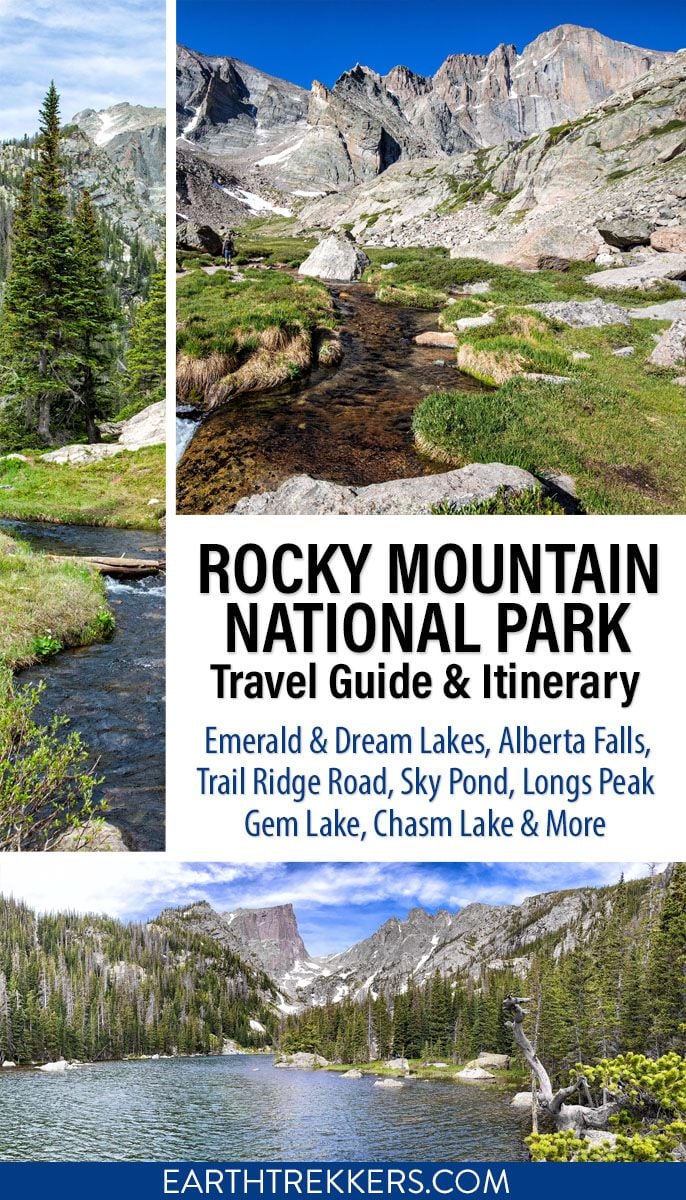
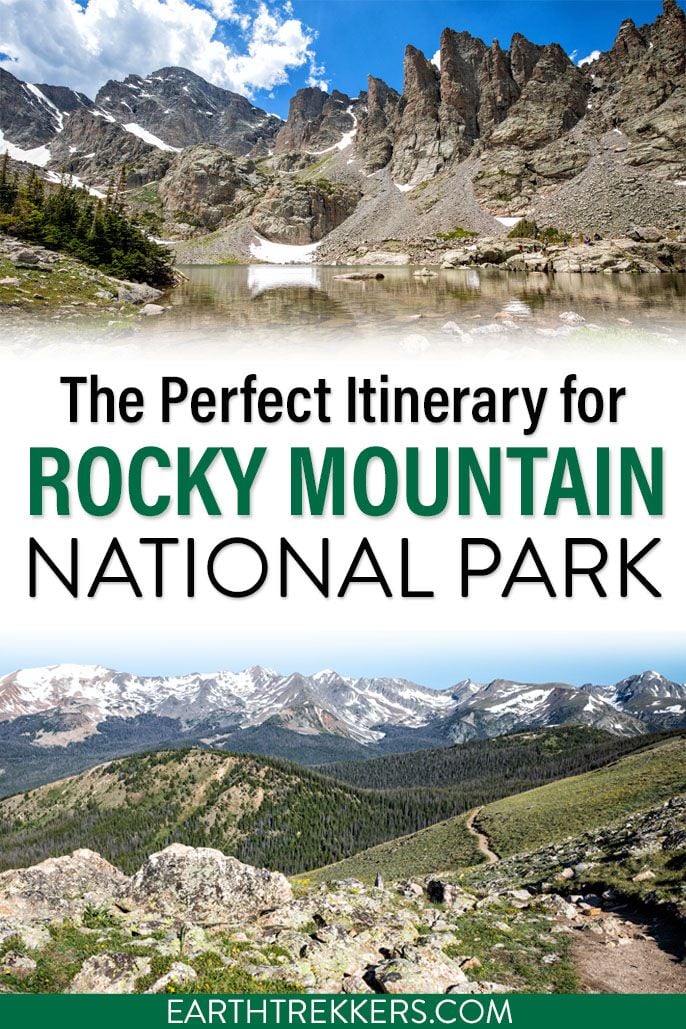
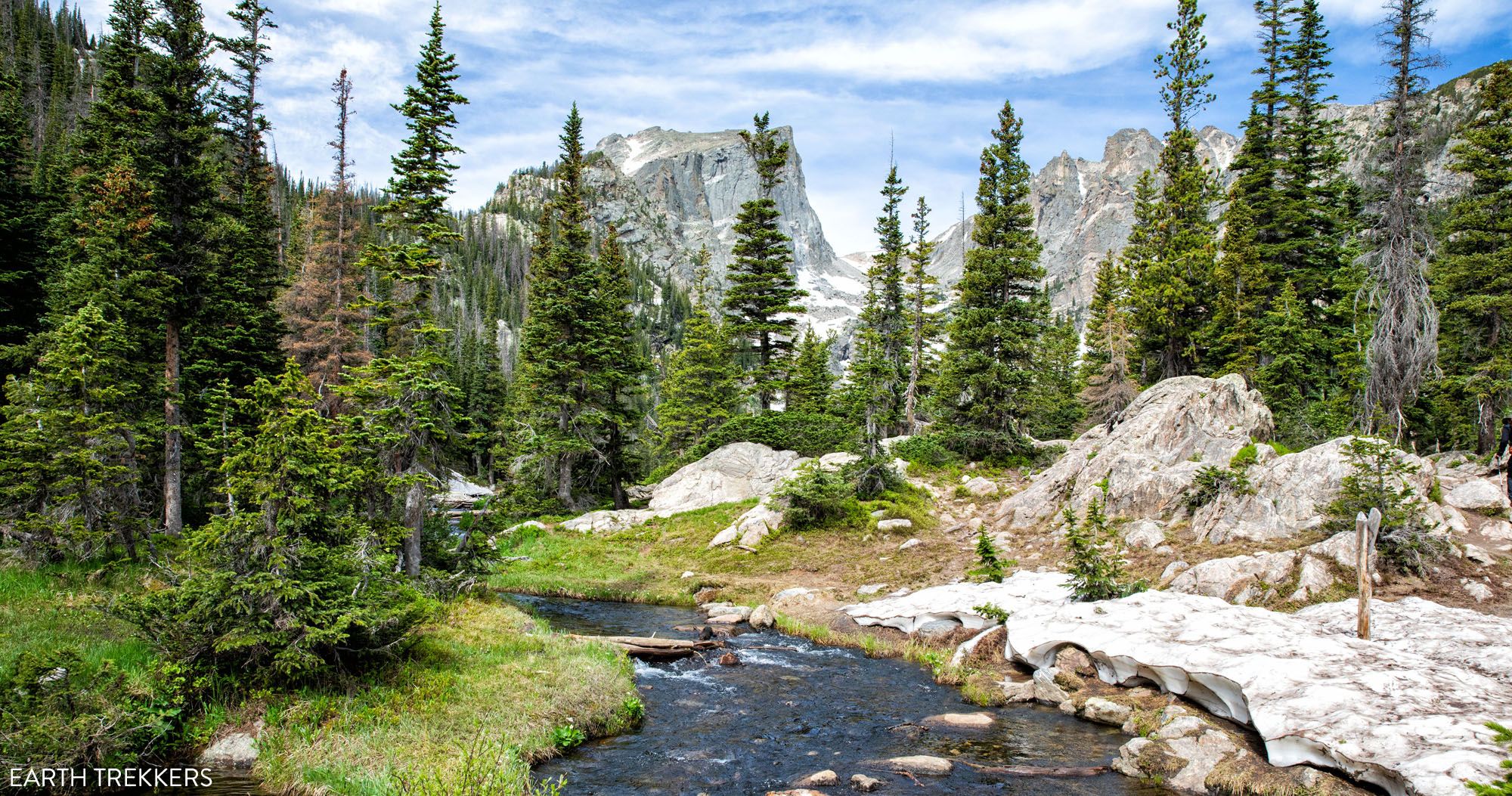
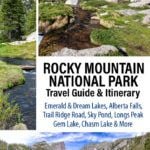
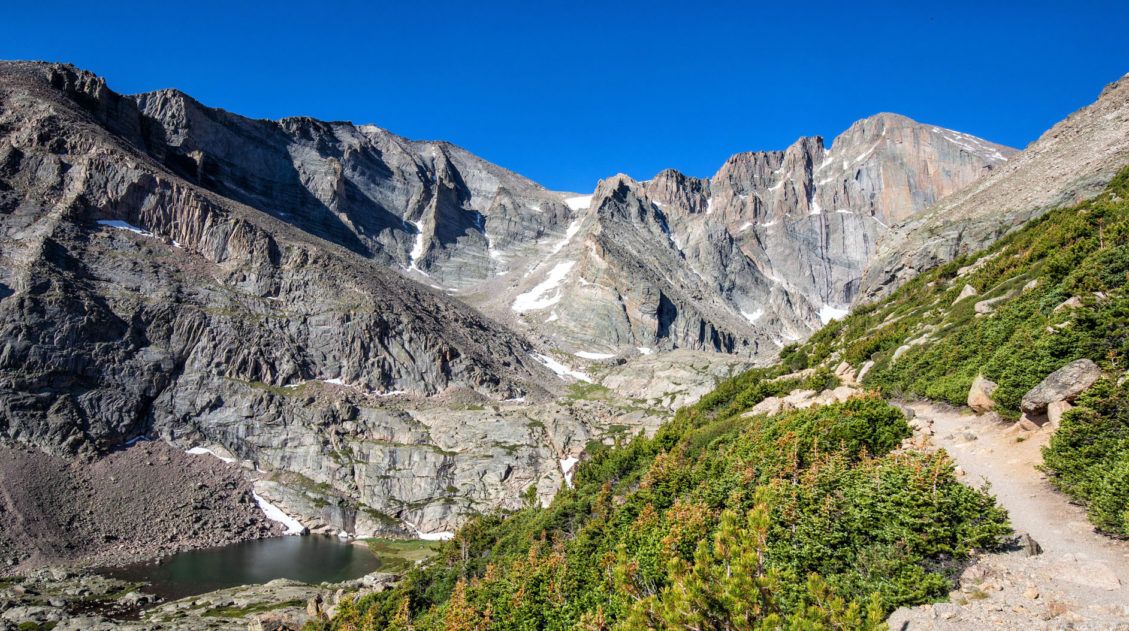
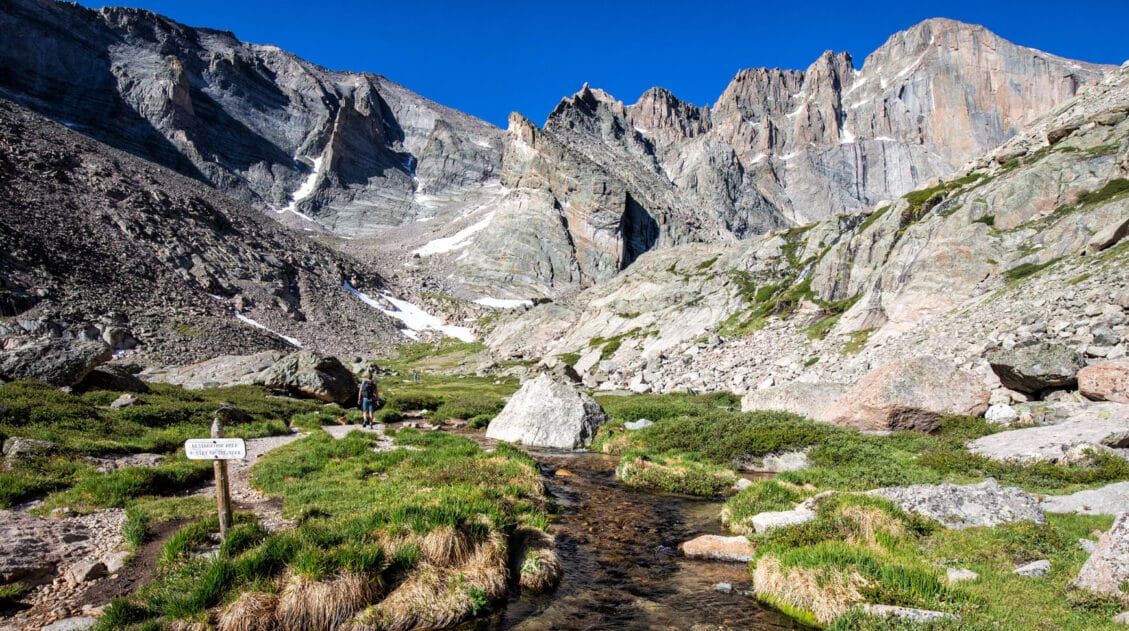
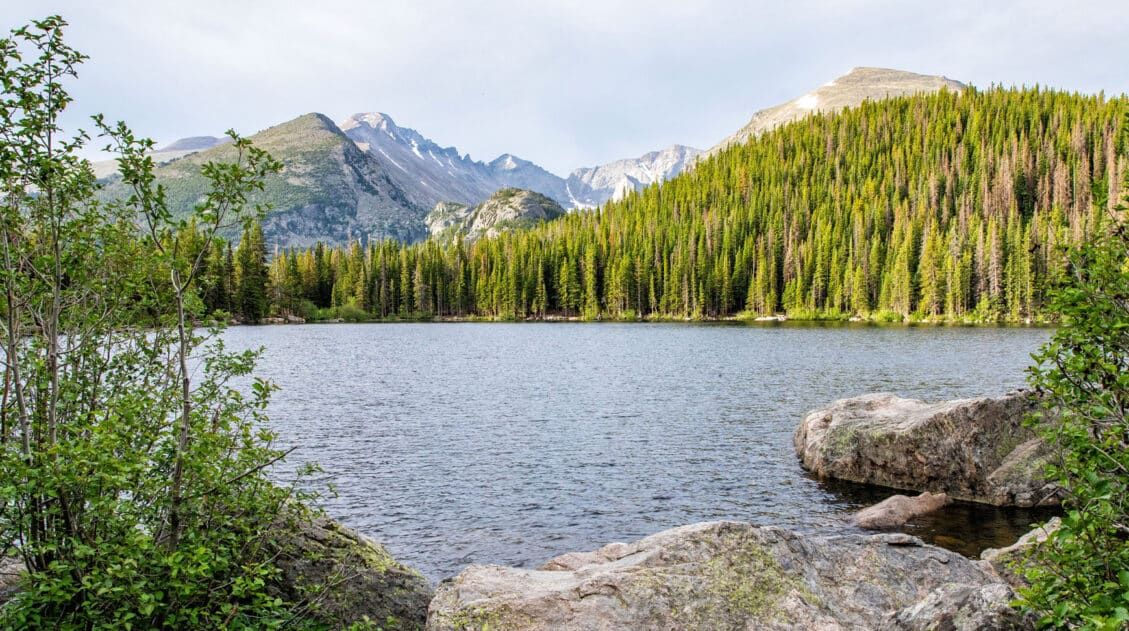
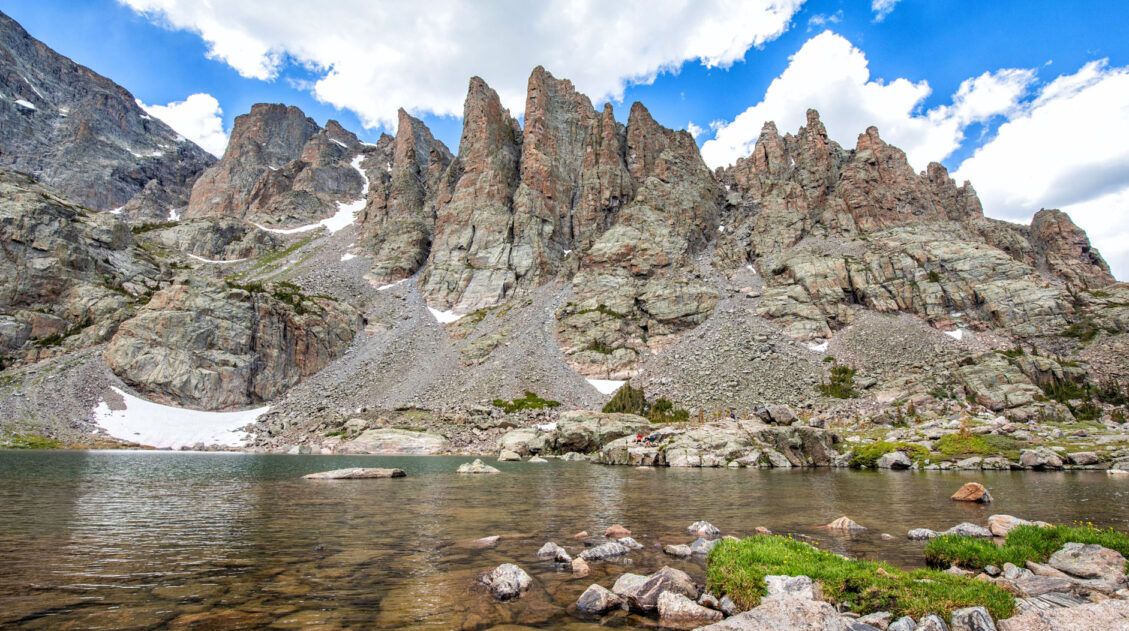
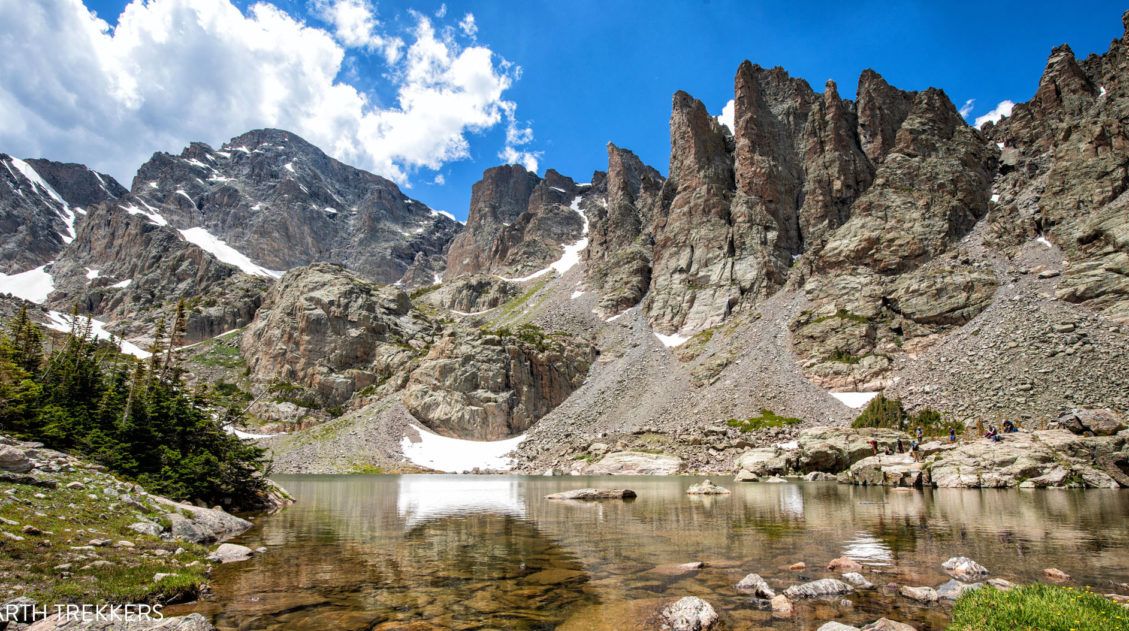
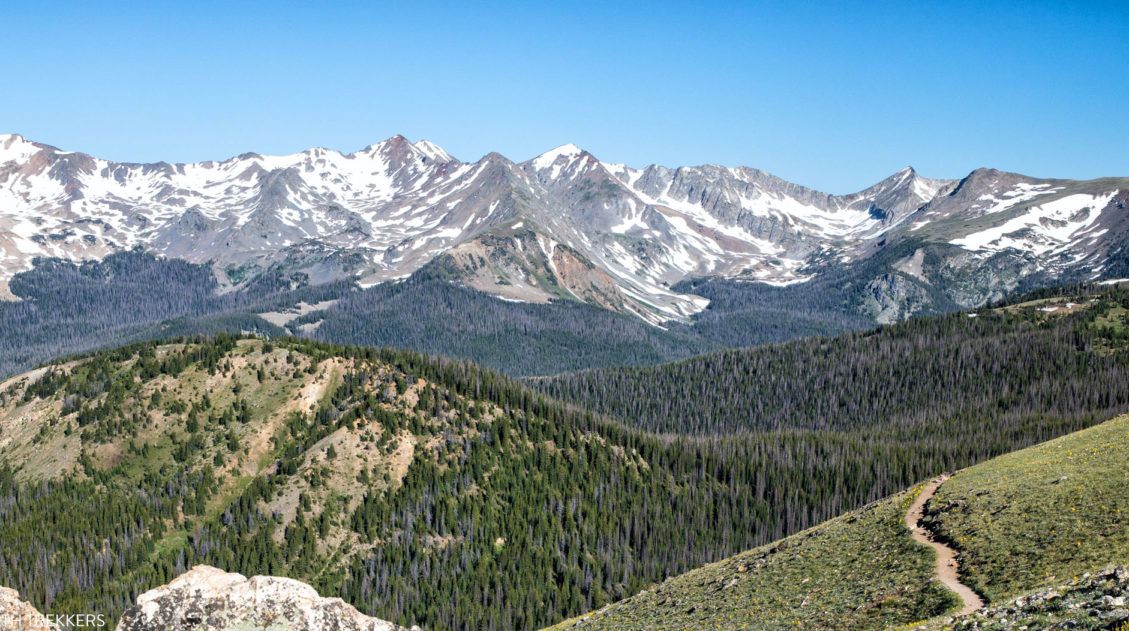
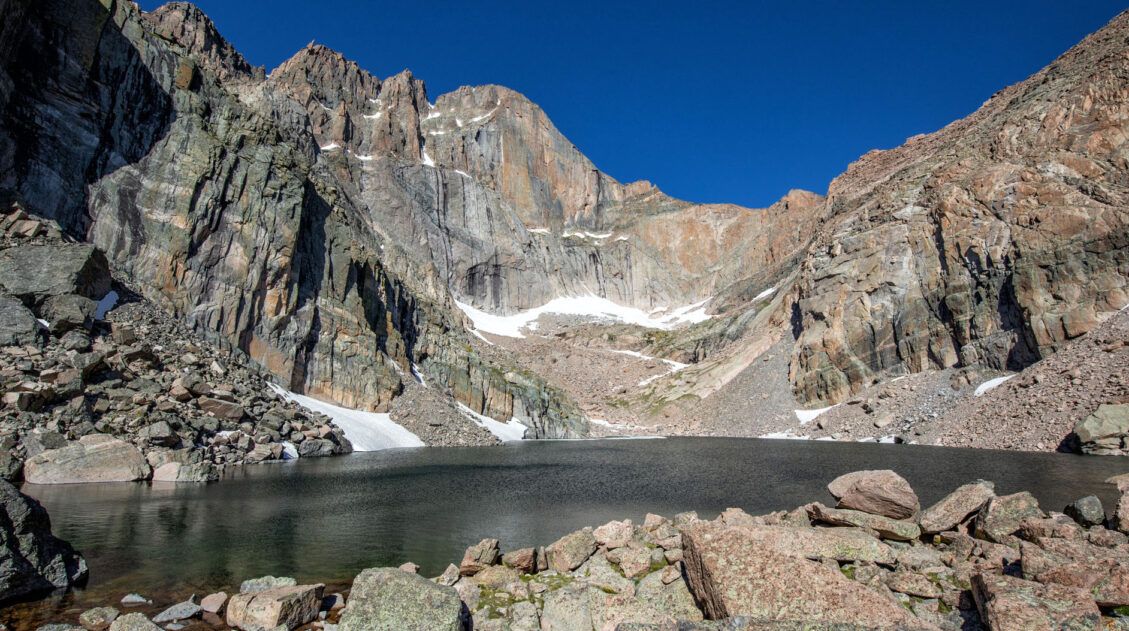
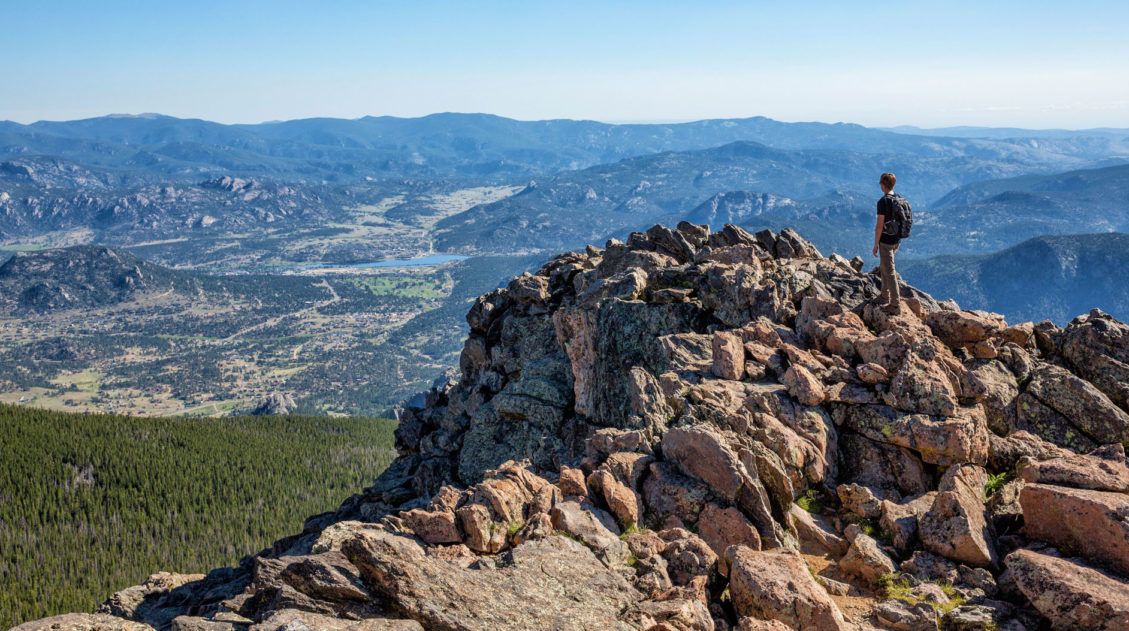
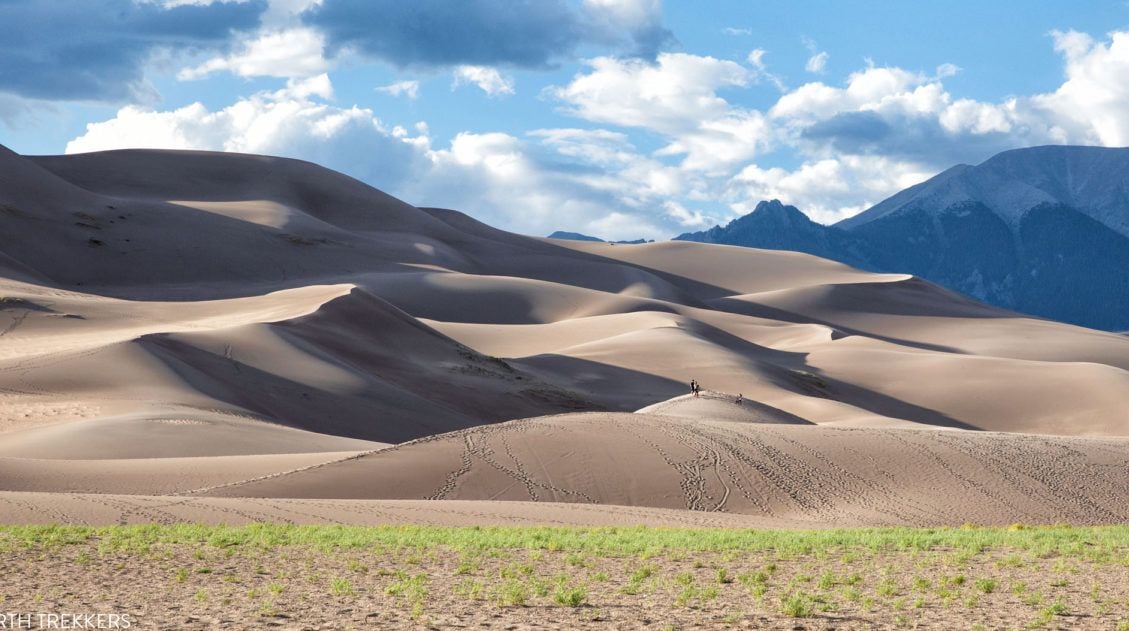
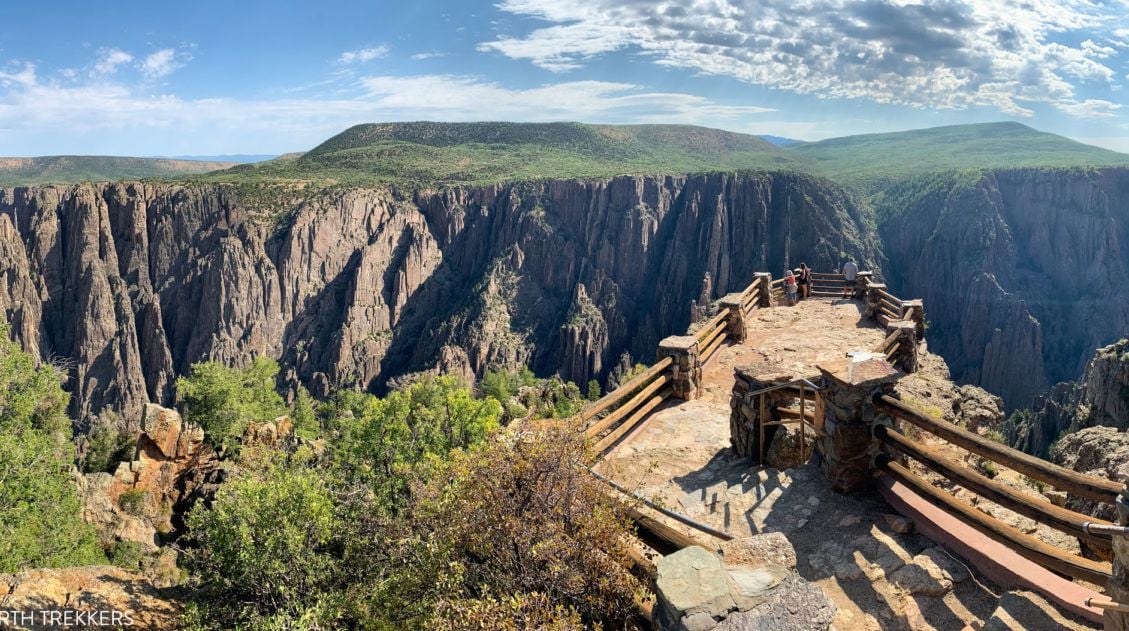
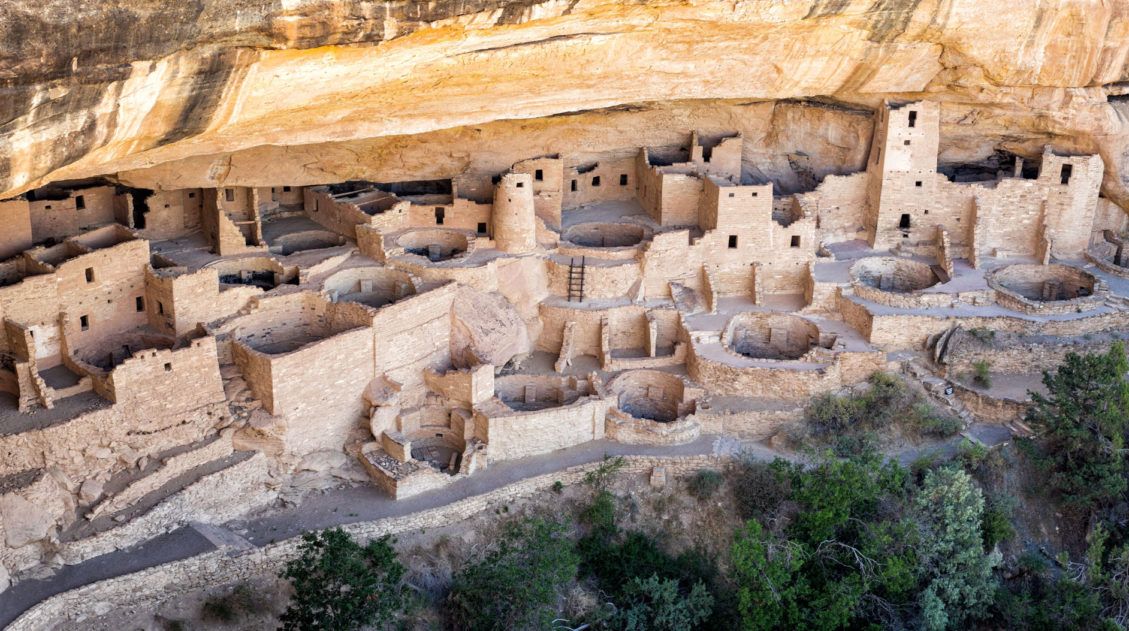
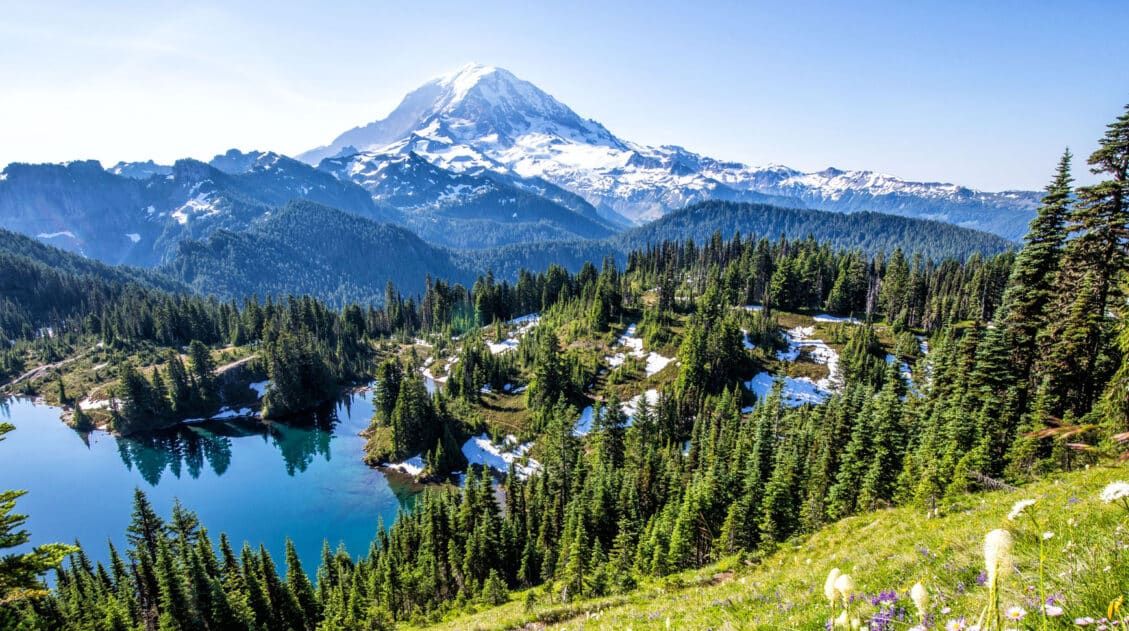
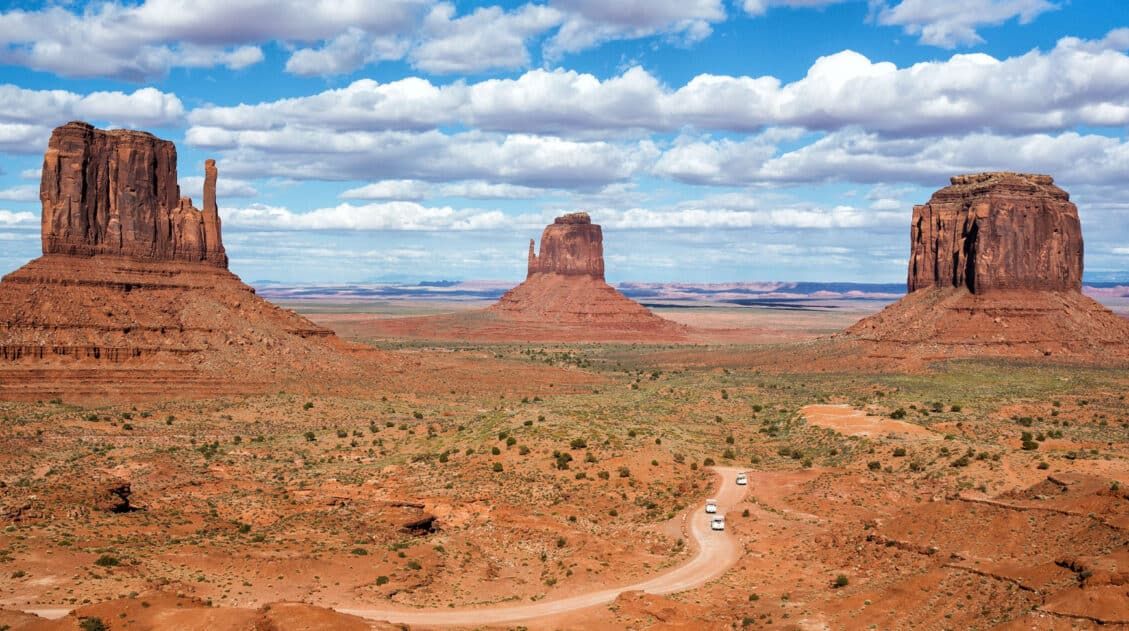
Comments 91